|
>
|
Can-Am
Links
Parentbooks stocks the titles
of hundreds of U.S. publishers… and there are a few with whom we have a special
relationship*. Scroll down, or click on the publisher logos below to view
their resources.
*a 10% discount applies to all professional-use purchases
of Social Thinking publications
From Autism Asperger Publishing Company
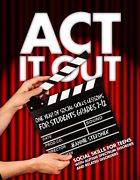
|
Act It Out: Social Skills for Teens with Autism
Spectrum Disorder and Related Disorders One
Year of Social Skills Lessons for Students Grades 7-12. Jeannie Stefonex,
$29.95
This innovative social skills curriculum addresses teens'
need to effectively use social skills across settings through motivating
scripts, skits, and guided practice. The curriculum is designed for the busy
teacher who wants to have fun, constructive lessons, giving students unique
opportunities to show their acting skills and experience emotional responses in
controlled environments. |

|
Ann Drew Jackson.
Joan Clark, $19.75
ANN DREW JACKSON lets children with and without autism
spectrum disorders get a glimpse of the frustrations that can drift
into people’s lives. Through the experiences of Jackson and Hillary
readers learn, from both sides of the spectrum, that people are
people despite life’s circumstances.
|
|
|
Applied Behavior Analysis for Everyone: Principles and
Practices Explained by Applied Researchers Who Use Them. Robert Pennington,
Editor, $48.95
An understanding of applied behavior analysis (ABA) can
help teachers, therapists, and practitioners improve the lives of those for
whom they are charged to care and serve. In this introduction to ABA, Robert
Pennington assembles a cast of talented researchers to describe in their own
words important behavioral concepts to an uninitiated audience.
The book, comprised of 17 brief chapters, is chocked full
of rich examples intended to help the reader navigate unfamiliar concepts and
behavioral terminology. The authors cover a range of topics from functional
assessment and intervention to instructional strategies for teaching a range of
skills to a range of populations. It is a perfect gateway into behavior
analytic practice for parents, educators, para-educators, registered behavior
technicians, and related service providers. |
Back to top
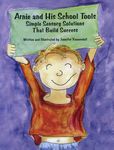
|
Arnie and His School Tools: Simple Sensory
Solutions That Build Success. Jennifer Veenendall, $25.95
ARNIE AND HIS SCHOOL TOOLS is an illustrated children's
book about an exuberant little boy who had difficulty paying attention
in class and doing his school work until he was equipped with the
tools to accommodate his sensory needs. Written from Arnie's point
of view, the book uses simple language to describe some of the sensory
tools and strategies he uses at school and home to help him achieve
a more optimal level of alertness and performance. Occupational
therapists, teachers and parents will find this book an engaging
way to introduce elementary students to basic sensory tools used
to help children focus in classroom settings, such as fidgets, chewy
pencil toppers, and weighted vests. Additional resources are provided
at the end of the book, including definitions of sensory processing
and sensory modulation disorder, suggested discussion questions,
and lists of related books and websites. |
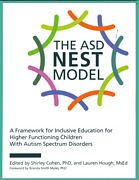
|
The ASD NEST Model: a Framework for
Inclusive Education for Higher Functioning Children with Autism Spectrum
Disorders. Edited by Shirely Cohen & Lauren
Hough, $46.95
This well-researched and evidence-based
program was formulated in response to the severe shortage of educational
programs designed for higher functioning school-age children with ASD, which
often leads to inappropriate placement, and a lack of supports... all of which
inevitably results in poor educational experiences. The program uses a positive
behavior support approach and incorporates strategies that address areas of
difficulties common in children with ASD, specifically sensory functioning,
social relatedness, self-regulation, managing anxiety, and selective cognitive
problems. This program helps children function comfortably and successfully in
mainstream settings in their schools and communities, whenever feasible, with
decreased need for professional support. |
|
The ASD Zoo of Kalamazoo. Josie Santomauro, $26.95
AAPC’s latest release, The ASD Zoo of Kalamazoo,
is an illustrated, rhyming children’s book that connects the characteristics of
various zoo animals to the major social skills characteristics of children with
autism spectrum disorder. The book demonstrates how some animals exhibit
specific characteristics, eccentric behaviors and special needs. The book
capitalizes on their strengths.
The goal of this book is for children to
recognize their characteristics and learn how to capitalize on them or adapt
for greater success in the social realm. This resource can be used with
children and their peers to talk openly about diagnosis, challenges and
differences, read by them or with an adult. Professionals can also use the
resource in schools or clinics. |
Back to top

|
Ask and Tell: Self-Advocacy
and Disclosure for People on the Autism Spectrum. Stephen Shore,
Editor. Foreword by Temple Grandin, $29.95 |
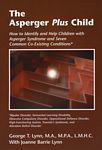
|
The Asperger
Plus Child: How to Identify and Help Children with Asperger Syndrome
and Seven Common Co-Existing Conditions. George Lynn &
Joanne Barrie Lynn, $28.95 THE ASPERGER PLUS
CHILD helps parents, educators and caregivers to understand the
Asperger child who has other conditions including Bipolar Disorder,
Nonverbal Learning Disorders, Obsessive Compulsive Disorder, Attention
Deficit Disorder. Written for parents, teachers, counselors, and
medical professionals, THE ASPERGER PLUS CHILD offers insights including:
- Why it is important to understand
the real difference between autism and Asperger Syndrome
- How you can tell if a child has AS
or ADD and why the distinction will become more important as the
child grows through his teen years
- What a child with AS who also has
a nonverbal learning disability looks like compared to a child
with AS without an NLD
Though each child is as different as a fingerprint,
there are shared patterns as well as important differences. THE
ASPERGER PLUS CHILD presents a commonsense, interesting, and understandable
description of these essential distinctions. |

|
Asperger Syndrome and
Adolescence: Practical Solutions for School Success. Brenda Smith
Myles & Diane Adreon, $30.95 |
Back to top

|
Asperger Syndrome:
an Owner’s Manual: What You, Your Parents, and Your Teachers Need
to Know. Ellen Heller Korin, $30.95 ASPERGER
SYNDROME: AN OWNER'S MANUAL is an interactive workbook designed
for young people, grades 5 through 8, for use with guidance from
a helping adult. Astutely written to be understood by these particular
adolescents, An Owner’s Manual describes what Asperger
syndrome is and how it can affect daily life. With the help of a
trusted adult, the child completes a series of exercises related
to learning style, sensory issues, emotions, relationships, and
more, culminating in a written plan for each major area of his life
that will serve as a constant guide and reinforcement. This unique
workbook not only reassures the young people that the things they
are struggling with can improve, but also empowers them by providing
a chance to identify their needs and to participate in developing
interventions and future planning.
|
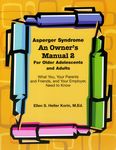
|
Asperger Syndrome: an Owner's Manual 2 For
Older Adolescents and Adults: What You, Your Parents and Friends,
and Your Employer, Need to Know. Ellen Heller Korin, $30.95
ASPERGER SYNDROME: AN OWNER'S MANUAL 2 FOR OLDER
ADOLESCENTS AND ADULTS is the eagerly anticipated sequel to Asperger
Syndrome: an Owner's Manual. This interactive workbook deals
with issues that older adolescents and adults face, such as relationships,
marriage, independent living, employment, and self-care. This much-needed
resource is designed to inform and support AS individuals as they
come to grips with their strengths and challenges and plan for a
successful adulthood within the neurotypical world. |
Back to top

|
Asperger Syndrome
and Sensory Issues. Brenda Smith Myles, Katherine Tapscott Cook,
Nancy E. Miller, Louann Rinner & Lisa A. Robbins; $23.95 |
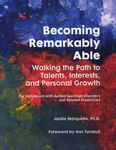
|
Becoming Remarkably
Able: Walking the Path to Talents, Interests and Personal Growth.
Jackie Marquette, $23.50
Preparing youth with autism spectrum for life after
high school requires fresh thinking and new actions from everyone
involved. BECOMING REMARKABLY ABLE is a system of ongoing assessments
with action steps, designed for family members and professionals
to guide an individual through an exploration process to identify
strengths and gifts that support emotional needs and promote growth.
This resource is helpful for individuals who are high functioning
as well as for those who have more significant disabilities. With
a focus on increased capability or independence, BECOMING REMARKABLY
ABLE helps establish goals and pursue paths for students in transition.
|
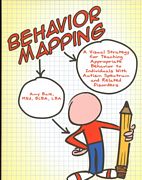
|
Behavior Mapping. Amy Buie, $30.95
A visual strategy for teaching
appropriate behavior to individuals with autism spectrum and related disorders. |
Back to top
|
Beyond Words: Using Paralanguage to Communicate
Effectively. Pat Crissey, $29.95
Our ability to understand nonverbal communication is
essential for successful social interactions. If we don't know what is being
communicated, how can we respond appropriately? In recent years, awareness has
been raised concerning the importance of understanding nonverbal communication,
including facial expressions, body language and tone of voice. Reading these
nonverbal clues has proven challenging for some individuals, including many on
the autism spectrum. Yet parents, teachers and therapists have often been left
to their own devices, as far as how to teach nonverbal communication. How does
one teach something so complex, yet so intuitive?
Beyond Words: Using Paralanguage to Communicate
Effectively was written to provide a sequence of teaching activities for
students struggling to understand paralanguage. It begins with a quick overview
for understanding emotions and body language. These topics are not covered in
detail in this curriculum, however some activities are provided, as well as a
list of resources for teaching these topics in more detail. This curriculum has
broken down paralanguage into its distinguishing characteristics; volume, rate,
emphasis and inflection, with a chapter devoted to each. The final chapter
entitled, Tone of Voice, integrates all of these different voice characteristics,
along with facial expressions and body language to give the student practice at
determining the speaker s emotional state in a more holistic way, considering
all aspects of nonverbal communication together.
The main emphasis throughout the curriculum is that it is
activity based. Like learning a new language, what is needed is a lot of
practice and repetition. A wide variety of engaging activities are used to
teach and reinforce skills, including listening practice, games, movie clips,
role-plays, and apps. This curriculum has two goals. The first goal is that
students become better communicators, both at expressing themselves as well as
understanding others. The second is that they have fun and enjoy the process of
learning these new skills. |
|
Building Independence: How to Create
and Use Structured Work Systems. Christine Reeve
& Susan Kabot, $48.95
Individuals with ASD and related
disorders are supported by a variety of people throughout their day, whether in
educational and work settings, transition programs or at home. Structured work
systems are one method that can be used to ensure that they develop and maintain
their ability to work on their own, without assistance and prompting from
others. Structured work systems are designed to give visual information about
what work needs to be done, how much works needs to be done, when the work is
completed and what will happen next. Due to the predictability and sense of
accomplishment that are built into the system, many individuals with ASD find
the structured work time their favorite time of the day. Full of color photos
and case examples spanning age and levels of functioning, the book provides an
A-Z guide to work systems, including assessment, how to build them into the
curriculum, IEPs, lesson planning and more. |
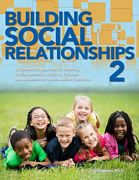
|
Building Social Relationships 2: a Systematic Approach
to Teaching Social Interaction Skills to Children and Adolescents on the Autism
Spectrum. Scott Bellini, $54.95
Building Social Relationships organizes the myriad
social skills strategies and resources currently available to make it easier
for parents and educational professionals to teach social skills and design
social skills programs for children with ASD. A comprehensive five-step model
addresses the need for social programming for children and adolescents with
ASD. This second edition, emphasizes the importance of targeting both social
skills and social-cognitive processing. |
Back to top
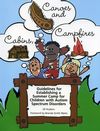
|
Canoes, Cabins and
Campfires: Guidelines for Establishing a Summer Camp for Children
with Autism Spectrum Disorders. Jill Hudson, $20.50
Many children with autism spectrum disorders
are not able to thrive in a typical summer camp due to their unique
sensory and behavioral needs. Yet, like all other kids they love
the camp experience. This book presents in clear and detailed terms
what it takes to put on a camp that takes into consideration the
special needs of children on the autism spectrum. |
|
The Classroom
and Communication Skills Program. Megan
Ahlers & Colleen Hannigan Zillich, $25.50
Practical strategies for educating young children with Autism Spectrum and other developmental disabilities in the public school setting. |

|
The Comprehensive
Autism Planning System (CAPS) for Individuals with Autism Spectrum
Disorders and Related Disabilities, 2nd Edition. Shawn Henry
& Brenda Smith Myles, $59.95
This system allows educators to
understand how to implement an instructional program for students with ASD.
Known as CAPS, the model answers common questions about finding the right
supports to fit a child’s learning style in order to help him reach his full
potential. Used with The Ziggurat Model, CAPS enables educators and other
professionals to address adequate yearly progress (AYP), response to
intervention (RTI), and positive behavior support (PBS). This expanded second
edition of CAPS adds important new material on technical
assistance/consultation as well as up-to-date considerations of current
mandates and trends that support CAPS use, including a major focus on
evidence-based practices. |
| |
A
Comprehensive Planning Process for Students with Autism Spectrum
Disorders and Related Disabilities: the Ziggurat Model and Comprehensive
Autism Planning System. Autism Asperger Publishing Company,
$7.50
The Ziggurat/CAPS Implementation Manual
offers an overview of the Ziggurat Model and CAPS followed by a
description of how they can be applied in various settings, an overview
of training parameters, and how various settings, an overview of
training parameters, and how the process can be used for one student
or adopted by an entire system. The manual ends with a brief overview
of assessment instruments that can be used to assess the impact
of the Ziggurat Model and CAPS on an individual and on the system.
|
Back to top
|
Conversation Club: Teaching Children with Autism
Spectrum Disorder and Other Social Cognition Challenges to Engage in Successful
Conversations with Peers. Lynn Cannon, Jonna Clark, Courtney Kornblum, Eve
Müller & Michal Powers, $69.95 (Instructor Manual & Storybook
Collection)
As a result of brain-based differences, individuals with
HFA experience significant social cognitive impairments that interfere with the
development of conversation skills. The Conversation Club curriculum
provides a comprehensive instructional framework for teaching both the “how”
and “why” of conversation. It is designed to target the needs of
elementary-aged children with high functioning autism (HFA) and other social
cognition challenges. The Conversation Club curriculum uses an adapted
version of the Teaching Interaction Procedure (TIP) framework. TIP is a model
for instruction that includes providing a rationale for why learning a skill is
important, breaking each skill into its component parts, demonstrating/modeling
the skill, and providing opportunities for students to practice the skill with
scaffolded support, feedback, and reinforcement.
Seven key goal areas are targeted — perspective taking
and social motivation; environmental awareness and body readiness; conversation
initiation and topic selection; topic maintenance; active listening behaviors
and attention to conversation; gaining attention behaviors; and conversation
breakdown and repair strategies. The book includes The Conversation Club’s
Progress Report, a checklist for instructors to use to gather baseline data as
well as monitor progress during the course of the intervention. |
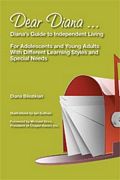
|
Dear Diana... Diana's Guide to Independent Living: For
Adolescents and Young Adults With Different Learning Styles and Special Needs.
Diana Bilezikian, $24.95
After graduating from high school, the author attended
Chapel Haven, a program for young adults with special needs and learning
differences. This practical resource is an outgrowth of a series of emails she
sent to relatives and friends about her life and the skills she was learning.
Backed by the president of Chapel Haven, Diana’s original ideas have been
expanded into a helpful collection of advice and support for how to live an
independent and meaningful life. Hints and suggestions are grouped under the
major headings of Life, Consumer, and Financial Skills; Communication and
Interpersonal Skills; Self-Care and Domestic Living; Getting Around; Stress
Management; Taking Charge, Managing Priorities, and Solving Problems; and
Safety and Emergencies. |
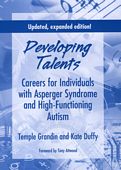
|
Developing Talents:
Careers for Individuals with Asperger Syndrome and High-Functioning
Autism, Revised Edition. Temple Grandin & Kate Duffy, $28.95
This career planning guide is written
specifically for high-functioning adolescents and young adults
on the autism spectrum, their families, teachers, and counselors.
The two authors weave together a unique blend of information
and advice based on personal experiences. Temple Grandin draws
from her own experience with autism spectrum disorders and
her professional career, and Kate Duffy uses her expertise
on employment issues and the mother of two teenagers with autistic-like
behaviors. The result is an extremely useful and practical
book that introduces step-by-step processes for the job search
with a major section on the impact ASD has in the workplace,
including managing sensory problems, how to nurture and turn
talents and special interests into paid work, jobs that are
particularly suited to individuals on the spectrum, and much
more. First-hand accounts of job experiences and advice from
individuals representing a broad range of careers particularly
suited for high-functioning individuals on the autism spectrum
round off this exciting new resource. |
Back to top

|
Difficult Moments
for Children and Youth with Autism Spectrum Disorders, DVD. Brenda
Smith Myles, $33.95, DVD 25 minutes
Daily life can present stress to all of us, but for individuals with
autism spectrum disorders everyday life can be particularly challenging.
When not addressed early on, stress can quickly escalate, culminating
in full-blown rage. Fortunately, there are signs along the way, if
only we know what to look for. In this DVD, Brenda Smith Myles, co-author
of Asperger Syndrome and Difficult Moments: Practical Solutions
for Tantrums, Rage and Meltdowns, shares her unique insights about
the rage cycle along with interventions for each stage, including
recommendations for adult behavior. |
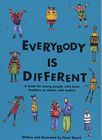
|
Everybody is Different
— a Book for Young People Who Have Brothers or Sisters with Autism.
Fiona Bleach, $17.95
Many young people have a hard time
understanding the complexities of what autism Is and why people with autism
engage in the behaviors that they do. This book gives answers to the many
questions brothers and sisters of young people on the autism spectrum have
about their siblings. In addition to explaining in basic terms the
characteristics of autism, this little book is full of helpful suggestions for
making family life more comfortable for everyone. The many illustrations make
this a warm and accessible book for young people. |
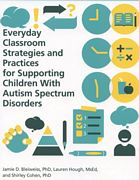
|
Everyday Classroom Strategies and
Practices for Supporting Children with Autism Spectrum Disorders. Jamie Bleiweiss, Lauren Hough & Shirley Cohen, $47.99
This practical approach to working with
students with autism spectrum disorders helps to demystify the processes needed
to help these students succeed and gives teachers the supports to plan
appropriately for them. Adopted by several schools and districts, this timely
resource clearly communicates how to create a classroom in which every learner
succeeds with specific and easy-to-implement strategies for students who
require minimal supports as well as those who require more intensive
interventions. In compliance with current trends in education, it incorporates
evidence-based practices, positive behavior supports, and uses Response to
Intervention. |
Back to top
|
|
Excelling with Autism: Obtaining Critical Mass Using
Deliberate Practice. Brenda Smith Myles, Ruth Aspy, Kerry Mataya &
Hollis Shaffer, $31.50
Most individuals with ASD and other related disorders are
taught skills only to a certain point. For example, an individual may learn to
read a calendar of assignments and check it the night before; however, he is
not totally independent on this task because he has not learned that you often
need to check your calendar more often than one night before an activity, such
as a test.
As adults, people on the spectrum may be taught to pay
bills and pay them on a timely basis when an invoice is provided. However, what
if there is no invoice — such as with rent. These challenges are directly
related to a lack of success in independent living, employment, and social
interactions. How do we change this trajectory?
We can help individuals reach critical mass. Think of
critical mass as beyond generalization — über generalization, if you will. It
is the point where an individual has gained enough information to apply it to
situations, activities or skills in which instruction has not been provided.
This book focuses on describing the factors that lead to critical mass for
those on the spectrum or other related disorders when providing instruction and
supports. Learn easy-to-use strategies that can help individuals with ASD to
move about their world as independently as possible, making informed decisions
about their wants and needs. Teaching to critical mass will help learners to be
successful not only with tasks they have been taught to do, but will also help
them to be successful with activities on which they have not received
instruction. |
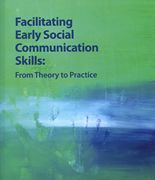
|
Facilitating Early Social Communication Skills: from
Theory to Practice. Pamela Rosenthal Rollins, $93.95
Learn how to design and implement a high-quality inclusive
program that helps young children with autism spectrum disorders develop social
communication and language skills.
This text presents a developmental social-pragmatic
approach to facilitating language and social communication. Consistent with the
SCERTS model (Social Communication Emotional Regulation and Transactional
Supports; Prizant et al.), it makes a major contribution to the training and
support of young children on the autism spectrum, ages 3-5. While the focus is
on the preschool environment, suggestions about how to extend the approach to
the home and other environments where the child with autism spends time are
provided. |
Back to top
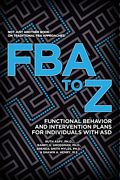
|
FB A to Z: Functional
Behavior and Intervention Plans for Individuals with ASD. Ruth Aspy, Barry
G. Grossman, Brenda Smith Myles & Shawn A. Henry, $34.50
FBA to Z: Functional Behavior and
Intervention Plans for Individuals with ASD is a practical guide to
developing comprehensive behavior intervention plans that highlight the need to
understand an individual’s unique needs and strengths within each phase. Using
a case study throughout the book, the authors address the unique
characteristics of individuals with ASD, ultimately resulting in the development
of comprehensive, meaningful, and effective interventions, based on the
specific needs of the learner. |

|
A "5"
Could Make Me Lose Control! An Activity-Based Method for Evaluating
and Supporting Highly Anxious Students. Kari Dunn Buron,
$38.95
Using this self-contained product, the
student literally sorts cards describing highly stressful situations
into colorful pockets designating stress levels, ranging from 5-1,
as a first step in changing the way he thinks about and responds
to emotions such as anxiety, sadness and anger. A laminated erasable
page and blank cards enable parents and teachers to individualize
this innovative program. Suggestions for how to include it as part
of a functional behavior assessment and a problem-solving activity
are included. |
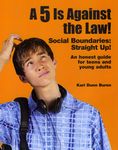
|
A ‘5’ Is Against
the Law! Social Boundaries Straight Up: an Honest Guide for Teens
and Young Adults. Kari Dunn Buron, $31.95
Building on her popular 5-Point Scale, Kari
Dunn Buron takes a narrower look at challenging behavior with a
particular focus on behaviors that can spell trouble for adolescents
and young adults who have difficulty understanding and maintaining
social boundaries. The notion behind the 5-point scale is to take
an idea or behavior and break it into five parts to make it easier
to understand the different degrees of behavior and, eventually,
the consequences of one's behavior. Using a direct and simple style
with lots of examples and hands-on activities, A ‘5’ IS
AGAINST THE LAW speaks directly to adolescents and young adults. |
Back to top
|
FLIPP the Switch: Strengthen Executive Function Skills.
Sheri Wilkins & Carol Burmeister, $34.95
Although many educators associate deficits in EF skills
with students on the autism spectrum, the reality is that many young people
struggle with executive functioning. In fact, it is accurate to say that all
young people are learning executive functioning as these skills are not fully
developed until people are well into their twenties. The good news is that
there are evidence-based strategies that can be used at home, in school, in the
community, and in work situations that can significantly improve the executive
functioning of individuals who struggle in this area. Given the right tools,
parents, educators, and others who work with this population can effectively structure
the environment and teach strategic thinking skills that will support the
critical life skills of flexibility, leveled emotionality, impulse control,
planning, and problem solving.
FLIPP the Switch is a practical book written for
parents and educators by parents and educators. The target audience is anyone
who works with young people aged 3-22 who are disorganized, inflexible,
impulsive, and who struggle with planning or problem solving. This book is
indispensable for anyone who wants to minimize conflict, maximize on-task
behavior, and support positive social-emotional development in a child or
student with challenging behavior. |

|
Friendly Facts:
a Fun, Interactive Resource to Help Children Explore the Complexities
of Friends and Friendship. Margaret-Anne Carter & Josie
Santomauro, $28.50 (ages 7-11)
Making and keeping friends doesn't come easily for
some children. Many children need to be taught a range of strategies
directed at expanding their social understanding skills, such as
reading facial expressions and body language. FRIENDLY FACTS, an
interactive workbook aimed at children ages 7-11, addresses these
challenges by breaking down the complex concept of making friends
into simpler ideas. Through fun, engaging activities, children gain
real-life knowledge of the major "secrets" of making and
keeping friends. By gaining the foundation for making and keeping
friends at a crucial age, children are better prepared for successfully
interacting with others for the rest of their lives. |
Back to top
|
Gear Up for Success: a Three-Tiered Planning Model for
Supporting Learners on the Autism Spectrum. Lisa Combs, Carol Dittoe &
Susan Aebker, $30.50
Using the analogy of shifting gears on a bicycle, this
three-tiered planning model provides educations teams with evidence-based
practices at three different levels of intensity to address the unique
challenges of students on the autism spectrum in a variety of common settings
and circumstances. The book not only gives an overview of many evidence-based
practices for teaching students with autism, but goes a step further by helping
educators understand how they can modify the delivery of those interventions
based on the intensity of the student's needs, instructional group size, and
other changing circumstances. |
| |
Genius Genes:
How Asperger Talents Changed the World. Michael Fitzgerald
& Brendan O'Brien, $25.50
GENIUS GENES: HOW ASPERGER TALENTS CHANGED THE WORLD
proposes that many famous historical figures had an autistic mind-style,
and that this should color the way we approach autism today. Arguing
that highly creative people are largely "born and not made,"
the authors present case studies of the lives of 21 famous individuals,
tying their personalities, talents and lifestyles to the major characteristics
of Asperger Syndrome. This book's chief importance lies in challenging
an often negative perception of autism and Asperger Syndrome by
demonstrating that many persons with autism spectrum disorders have
lived rich, complex and productive lives, and that their intelligence
and special talents contributed hugely to shaping the world that
we now know. |
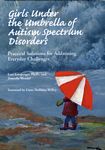
|
Girls Under the
Umbrella of Autism Spectrum Disorders: Practical Solutions for Addressing
Everyday Challenges. Lori Ernsperger & Danielle Wendel,
$29.95
GIRLS UNDER THE UMBRELLA provides insightful first-hand
accounts along with research-based strategies and practical techniques
for addressing the unique needs of girls on the spectrum. Each chapter
includes descriptions of interventions and strategies designed to
improve specific behaviors at home, at school, and in the community.
Throughout, the emphasis is on what sets girls apart from boys on
the spectrum in an effort to ensure that their unique needs are
met and their special talents are fostered and nurtured. |
Back to top
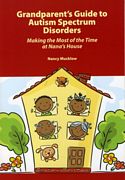
|
Grandparent’s Guide to Autism Spectrum Disorders. Nancy Mucklow, $29.95
Most children fit almost instinctively
into Grandma's. Children with ASD have a harder time adjusting and even a brief
visit can leave a grandparent mentally and physically exhausted. But it doesn't
have to be that way!
Nancy Mucklow's book serves as a
practical guide to turning grandparents' concern, confusion and initial sadness
for their grandchild with ASD into a relationship of acceptance, confidence and
realistic expectations. Full of intriguing and thought-provoking anecdotes and
rules of thumb, GRANDPARENT'S GUIDE TO ASD includes tried-and-true
recommendations on how to deal with sensory issues, new and unfamiliar environments,
dietary considerations, emotional meltdowns, communication, selecting the right
toys, participating in school and family events... and much more. More
knowledgeable and better prepared after reading this positive and upbeat book,
grandparents can stay relaxed as they use the helpful strategies that allow
them to better connect with their special grandchild. |
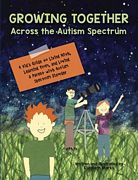
|
Growing Together Across the Autism Spectrum: a Kid’s
Guide to Living With, Learning From, and Loving a Parent With Autism Spectrum
Disorder. Elizabeth Marks, $20.25
A parent with ASD can provide his or her children deep
love and support, along with a perspective on the world that is wonderfully
unique. At the same time, the emotional and physical demands of parenting can
be taxing for someone with autism.
Growing Together Across the Autism Spectrum tackles a topic that has
received little attention – the relationship between a neurotypical child and a
parent on the spectrum. As such, this illustrated children’s book
provides a conversational starting point for families with a parent on the
autism spectrum. While narrated from the perspective of a boy whose father has
ASD and a mother who does not, his thoughts and questions apply equally to
other variations of this family structure.
While an ASD parent craves order, reason, and predictability, the experience of
parenthood is inherently chaotic. This book fills a critical gap in resources
for children and families with parents on the autism spectrum. It takes
children’s feelings of love, confusion, and worry seriously and promotes mutual
respect, affection, and accountability among family members. Overall, this
title reflects the importance of every family member’s commitment to growing
together. |
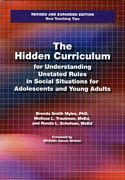
|
The Hidden Curriculum
for Understanding Unstated Rules in Social Situations for Adolescents
and Young Adults. Brenda Smith Myles, Melissa Trautman
& Ronda Schelvan, $30.50
In the revised and expanded edition of this popular book, the authors
narrow their target to issues common to adolescents and young adults.
While many of the features of the original book have been maintained,
information on evidence-based practice has been added. Further,
a series of instructional strategies are provided that can be used
to teach the hidden curriculum. Instructional aids include charts,
forms, and templates designed to make the job of teaching and learning
the hidden curriculum more effective. |
Back to top
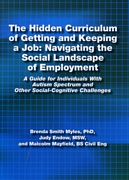
|
The Hidden Curriculum
of Getting and Keeping a Job: Navigating the Social Landscape of
Employment, a Guide for Individuals with Autism Spectrum and Other
Social-Cognitive Challenges. Brenda Smith Myles, Judy Endow
& Malcom Mayfield, $32.95
Adults on the spectrum often have
difficulty getting and keeping a job that is unrelated to their job skills.
This practical and easy-to-use book provides necessary yet often untaught
information on a variety of topics related to getting a job, finding a mentor,
networking, using agencies, interviewing, talking with supervisors, dealing
with on-the-job-frustrations, understanding the social rules at work and many
other topics. |
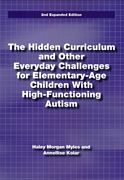
|
The Hidden Curriculum and Other
Everyday Challenges for Elementary-Age Children with High-Functioning Autism. Haley Morgan Myles & Annelise Kolar, $26.50
In this 2nd expanded edition, previously
entitled PRACTICAL SOLUTIONS TO EVERYDAY CHALLENGES FOR CHILDREN WITH
ASPERGER SYNDROME, young authors Haley Myles and Annellise Kolar give simple,
no-nonsense advice on how to handle everyday occurrences that can be
challenging for children on the autism spectrum. This reader-friendly book
provides social rules that help children with peer relationships, school and
everyday activities. New hidden curriculum tips, including tips on Internet
safety, provide children essential social rules for succeeding in an ever-changing
interactive world. |
Back to top
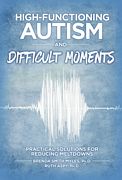
|
High-Functioning Autism and Difficult Moments:
Practical Solutions for Reducing Meltdowns. Brenda Smith Myles & Ruth
Aspy, $30.95
This book offers tried-and-true solutions to minimize and
circumvent the often frightening circumstances that surround the rage cycle,
not only for the child with high-functioning autism, but others in the
environment as well. A highly practical and user-friendly resource, High-Functioning
Autism and Difficult Moments focuses on the reactions of the adults around
the child. The authors take the reader through the stages of the rage cycle and
emphasize the importance of utilizing the teachable moments before and after a
rage episode. |
|
“I Hate To Write!” Cheryl
Boucher & Kathy Oehler, $35.95
Tips for helping students with autism spectrum and
related disorders increase achievement, meet academic standards, and become
happy, successful writers. |
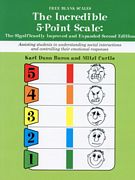
|
The Incredible 5-Point Scale, 2nd
Edition: Assisting Students with Autism Spectrum Disorders in Understanding
Social Interactions and Controlling Their Emotional Responses. Kari Dunn Buron & Mitzi Curtis, $30.50
The second edition of the wildly
popular INCREDIBLE 5-POINT SCALE is significantly improved and
expanded. Using the same practical and user-friendly format as the first
edition, readers benefit from work done with the scales over the past 10 years,
resulting in refinements to the original scales, now considered
"classics" in homes and classrooms across the country and abroad. As
well there are lots of new scales specifically designed for young children and
for those with more classic presentations of autism, including expanded use of
the Anxiety Curve. Another welcome addition is a list of goals and objectives
related to incorporating scales in students' IEPs. As in their other writings,
the authors emphasize the importance of self-management and self-regulation,
two evidence-based practices.
Purchasing the book allows online access
to blank scales, small portable scales and worksheets for easy duplication. |
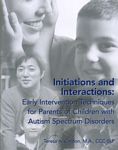
|
Initiations and
Interactions: Early Intervention Techniques for Children with Autism
Spectrum Disorders. Teresa Cardon, $20.50
Research suggests an early start is the key to a
successful intervention for children diagnosed with an autism spectrum
disorder. What many don't know is that research also shows that
for most early intervention programs to be effective, they must
involve a child's primary caregivers, especially when it comes to
such an all-pervasive area as communication. If your child is currently
receiving several therapies or if you are trying on your own to
help encourage and foster communication interactions with your child,
take the tools you find helpful in this book and make sure that
a "family-centered" approach is part of your weekly regime.
If your child is one of the thousands who have been "wait-listed"
for services, wait no more — the tools are at your fingertips! |
Back to top
|
The Integrated
Self-Advocacy ISA Curriculum: a Program for Emerging Self-Advocates
with Autism Spectrum and Other Conditions. Valerie Paradiz,
Teacher Manual, $38.95; Student Workbook, $18.50
Self-advocacy plays a vital role
in nearly every aspect of life for individuals on the spectrum,
in school, at home, in the community, and at work. The more
self-awareness people on the spectrum possess, the more they
can be players in advocating for their own comfort, happiness,
and well-being. This cutting-edge curriculum helps professionals
and family members provide children and adults with ASD with
safe forums for self-discovery, structured learning activities,
and a cumulative understanding of the many facets of self-advocacy.
The 12 units included in the Teacher Edition and Student Workbook
provide a comprehensive curriculum with detailed lesson plans,
worksheets and activities, culminating in the creation of a
personal self-advocacy portfolio, a living document that can
be adjusted over the life span. |
|
Interoception: the Eighth Sensory System. Kelly
Mahler, $34.95
Many people take it for granted, but one of the most
important skills we have is being able to understand signals from our body. How
you know if you’re hungry, thirsty, tired, etc. are key abilities to live a
healthy life. These are also skills that those with autism spectrum disorder
tend to lack. Kelly Mahler’s newest book gives professionals and parents a new
way to consider teaching these talents to individuals with ASD. She describes
the clear link between interoception and many important skills such as
self-awareness, self-regulation, problem solving, intuition, and many more.
Also available: The Comprehensive Assessment for
Interoceptive Awareness. Kelly Mahler, $35.75
Interoception: The Eighth Sensory System describes
author Kelly Mahler has designed various assessments to accompany the book,
which give professionals and parents a new way to evaluate individuals with ASD
and provide targeted strategies to overcome challenges. This kit contains 10
assessment booklets, and accompanying photos. |
|

|
Jackson Whole
Wyoming. Joan Clark, $19.95
Tyler is confused when he is selected by his entire fifth-grade class
to present a going-away gift to Jackson, a classmate who is moving
out of town. The agonizing dilemma is that while Tyler likes Jackson,
he is a little embarrassed to admit it, and is worried about being
"lumped together" with Jackson, whom many of the other students
view as a bit "strange." The truth of the matter is that
Jackson has Asperger Syndrome, which explains his sometimes bizarre
behavior and lack of social skills. In the end, Tyler's kind nature
prevails and he does a wonderful job of presenting a class book to
the departing Jackson. This heart-warming and often humorous book
paints a realistic picture of the ups and downs in the life of a fifth-grader
and, more important, of a young boy with Asperger Syndrome. |
Back to top
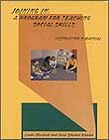
|
Joining In!
A Program for Teaching Social Skills. Linda Murdock & G.S.
Khalsa, $85.95 |
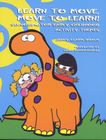
|
Learn to Move, Move
to Learn: Sensorimotor Early Childhood Activity Themes. Jenny
Clark Brack, $48.50
Learn to Move, Move to Learn: Dinosaurs.
Jenny Clark Brack, $37.95 (DVD, 19 minutes) |
Back to top
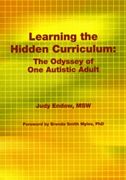
|
Learning the Hidden
Curriculum: the Odyssey of One Autistic Adult. Judy Endow, $29.75
Drawing from her personal experiences,
Judy Endow provides lots of hidden curriculum items that pertain to most areas
of adult life. In relating how she personally has learned to more successfully
maneuver social interactions, she also presents a framework for developing the
ability to more quickly assess a situation and take steps to avoid making
social blunders before they have been committed. A sampling of strategies
includes Pause and Match, Laugh Along, Recognize and Expand Black-and-White
Thinking, and It Is Not Necessary to Report All My Truths. Judy's framework
enables readers to learn to create their own social "rules" and, as a result,
live freer, more successful lives. |
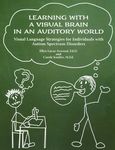
|
Learning with
a Visual Brain in an Auditory World: Visual Language Strategies
for Individuals with Autism Spectrum Disorders. Ellyn Lucas
Arwood, & Carole Kaulitz, $40.95
Children diagnosed with an autism spectrum
disorder (ASD) often present parents and educators with perplexing
symptoms. Even though the skills of children with ASD can range
from very high to very low, they have similar underlying learning
systems. Knowledge about these learning systems helps provide direction
for choosing effective assessment and intervention methods for helping
individuals with ASD learn to behave, to perform academically, and
to become socially competent. |
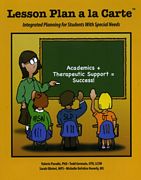
|
Lesson Plan a la Carte: Integrated Planning for
Students with Special Needs. Valerie Paradiz, Todd
Germain, Sarah Olivieri & Michelle DeFilice Haverly, $27.50
LESSON PLAN A LA CARTE guides teachers,
clinicians and administrators through a simple, step-by-step process for
creating an integrated lesson plan that addresses the social, environmental and
communication challenges that often block students' access to academics and
other learning. As the slim, 90-page volume indicates, the authors don't want
to add more work to educators' already busy day. The book makes an educator's
existing workload easier to manage by helping them create well-designed and
integrated lesson plans that bring together learning objectives, therapeutic
supports and modifications students need in the classroom. These plans can then
be carried out solo or by a team. Guided instructions are printed on all
template forms which are provided in the book as well as on the accompanying
CD. |
Back to top
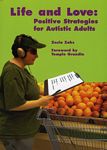
|
Life and Love:
Positive Strategies for Autistic Adults. Zosia Zaks, $27.95
Written for adults on the spectrum and
those involved – parents, spouses, friends – this book is divided
into two sections: life and love. In the life section, the author
describes and suggests concrete ways to deal with daily living.
In the love section, the author includes a broad spectrum of suggestions
for different types of relationships and weaves these together with
the core concept of self-esteem. |
|
Make Social Learning Stick! How to Guide and Nurture
Social Competence through Everyday Routines and Activities. Elizabeth
Sautter, $36.95
This book offers a “social learning diet” of concepts and
actions that can be used in everyday life to increase verbal and nonverbal
language, listening skills, understanding of hidden rules, perspective taking, executive
functioning, and more. The activities are recipes for social and emotional
learning for which parents, teachers, and therapists typically already have the
ingredients. With close to 200 fun and easy activities, including contributions
from leading experts, this book offers numerous ways to embrace teachable
moments throughout daily routines without having to do extra work! Events like
getting ready for school, preparing dinner, going to the doctor, and
celebrating Thanksgiving become opportunities for teaching and reinforcing
expected social behavior. Geared toward children in preschool through
elementary school, the ideas are meant to inspire creativity that suits each
specific child. Activities can be easily tailored to meet a child’s
developmental level, needs, or challenges. |
Back to top

|
My Best Friend Will.
Jamie Lowell & Tara Tuchel, $28.95
Enter Willie's world through Jamie's
eyes as it unfolds at school, at home, and at play. In the process,
you will gain a rich understanding and appreciation of Willie's
many unique qualities and come to accept that these are all a part
of who he is. |
|
My New School:
a Workbook to Help Students Transition to a New School. Melissa
Trautman, $29.95
Venturing into the unknown can be scary and when it comes to changing schools, it helps to have a plan. This workbook is a practical guide that will ease the transition and help you to make new friends. |
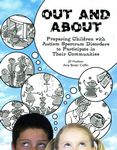
|
Out and About:
Preparing Children with Autism Spectrum Disorders to Participate in
Their Communities. Jill Hudson & Amy Bixler Coffin, $27.95
|
Back to top
|
The Parent's Guide to College for Students on the
Autism Spectrum. Jane Thierfeld Brown, Lorraine
Wolf, Lisa King & G. Ruth Kukiela Bork, $39.95
Sending a son
or daughter off to college is daunting and fear-provoking experience for most
parents, but if your child has an autism spectrum disorder, the challenge is
magnified many times over. Even high-functioning students with excellent
academic preparation face difficulties in higher education, primarily related
to communication, social skills, and sensory-based issues. For many, the
accommodations and special interventions that supported them in high school
will no longer be available on a college campus. This parent-friendly book,
made especially so because it is written by parents, who also are autism
professionals, takes the fear and mystery out of the college experience. Learn
how to select the right campus, how to work with Disability Services staff,
what legal protections apply, how to prepare your son or daughter to be an
effective self-advocate on campus, what assistance can be reasonably be
expected from residence hall managers, faculty, and much, much more. |
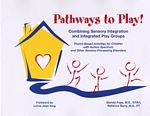
|
Pathways to Play! Combining
Sensory Integration and Integrated Play Groups. Glenda Fuge &
Rebecca Berry, $32.50 |

|
Peer Play and the Autism
Spectrum: the Art of Guiding Children's Socialization and Imagination.
Pamela Wolfberg, $54.95 |
Back to top

|
Perfect Targets: Asperger
Syndrome and Bullying; Practical Solutions for Surviving the Social
World. Rebekah Heinrichs, $21.50 |
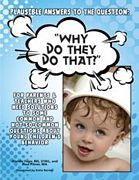
|
Plausible Answers to the Question: "Why Do They
Do That?" Glenda Fuge & Paul Pitner, $31.50
This is a hands-on reference for parents, caregivers, and
teachers that takes a unique approach to behaviors that often dismay and
puzzle adults. Using a practical and reader-friendly format, the book presents
solutions to some common and not-so-common questions about young children's
behavior. |
Back to top
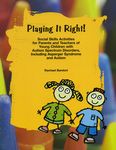
|
Playing It
Right: Social Skills Activities for Parents and Teachers of Young
Children with Autism Spectrum Disorders. Rachael Bareket,
$29.95
This collection of practical, hands-on social skills activities
are easy for both parents and teachers to carry out with the child.
The activities result in a finished product that can serve as a
reminder to reinforce skills in addition to practicing reading,
writing, fine-motor skills and more.
|
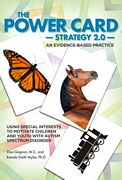
|
The Power Card Strategy 2.0: an Evidence-Based
Practice Using Special Interests to Motivate Children and Youth with Autism
Spectrum Disorder. Elisa Gagnon & Brenda Smith Myles, $30.95
Many researchers, parents, and autistics themselves have
long understood the role of special interests in teaching and motivating
individuals with autism spectrum disorder (ASD), yet these intense areas of
knowledge have not been widely integrated into the learning activities of
children on the spectrum. It was author Elisa Gagnon’s insightful and
innovative first edition of Power Cards that helped move the use of
special interests forward, promoting classroom-based research on the deep areas
of knowledge and learners on the spectrum. The authors are hopeful that the
second edition of this book will further inspire professionals and parents to
incorporate special interests into the lives of learners on the spectrum. |
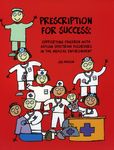
|
Prescription
for Success: Supporting Children with Autism Spectrum Disorders in
the Medical Environment. Jill Hudson, $26.50 (comes with
CD-ROM) Because of the unique needs of children
with ASD, it is important to pay special attention to the details
of their experience in the medical environment. Designed to help
make the medical experience easier for all involved, this book presents
information on ASD, the varying developmental levels, interventions,
and assessments that medical staff, parents, educators, and key
service providers can use to more effectively interact with and
support children with ASD while in the medical setting. The information
and techniques presented in PRESCRIPTION FOR SUCCESS can
be used by doctors, nurses, medical technicians, residents, interns,
and even administrative staff to support children with ASD and their
families in what can otherwise be trying circumstances. A CD at
the back of the book includes forms and worksheets that can be printed
and duplicated. |
Back to top
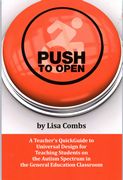
|
PUSH to Open. Lisa Combs, $28.50
A teacher's quick guide to universal design for teaching
students on the autism spectrum in the general education classroom. Simple,
straightforward solutions to a complex problem! |
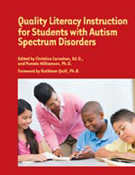
|
Quality Literacy Instruction
for Students with Autism Spectrum Disorders. Christina Carnahan
& Pamela Williamson, Editors, $74.95
This is a practical and invaluable text for anyone who is interested in helping emergent readers become proficient readers with a particular focus on how the unique characteristics of learners with autism spectrum disorders interact with the development of literacy. |
Back to top
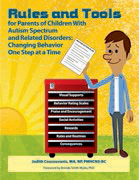
|
Rules and Tools for Parenting Children with Autism
Spectrum and Related Disorders: Changing Behavior One Step at a Time. Judith
Coucouvanis, $33.95
Rules and Tools for Parenting Children With Autism
Spectrum and Related Disorders will guide parents throughout their journey
toward understanding their child, and solving problems related to behavior.
Using the 119 rules and tools presented here in their Parenting Toolbox,
parents will now be able to help their child be successful. Using checklists,
forms, and other practical tools, parents will eventually develop their child’s
personal MAP — Master Action Plan. |
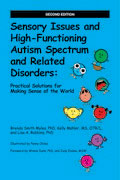
|
Sensory Issues and High-Functioning Autism Spectrum
and Related Disorders: Practical Solutions for Making Sense of the World. Brenda
Smith Myles, Kelly Mahler & Lisa Robbins, $30.95
Using the same product and easy-to-read format as the
first edition, this newly expanded book explains how many children with
high-functioning ASD relate to the world through their senses. The book reviews
sensory processing terminology and how the sensory systems impact
behavior. An expanded discussion of assessment tools is followed by a
comprehensive chapter on evidence-based interventions. Finally, a new
chapter looks at meeting a student's sensory needs throughout the day and
across environments using simple and easy-to-use forms and checklists. |
Back to top
|
Setting Up Classroom
Spaces that Support Students with Autism Spectrum Disorders.
Susan Kabot & Christine Reeve, $41.95
Using evidenced-based practice, SETTING UP CLASSROOM SPACES
helps teachers and educational assistants to create classroom
environments that facilitate leaning for students with ASDs. |
|
Show Me! A Teacher's Guide to Video Modelling. Carol Dittoe & Heather Bridgman, $27.95
With the technology we have today (tablets, smartphones,
applications), implementing video modeling is easier than ever! This book is
meant to inspire readers to think about how they can use video modeling by
providing many real-life examples of students who have used and found benefits
from watching video to learn social skills, positive behaviors, and academics.
A helpful planning guide is provided to help teams get started and more easily
implement the video-modeling strategy. |
Back to top

|
Sibling Stories: Reflections
on Life with a Brother or Sister on the Autism Spectrum. Lynne
Stern Feiges & Mary Jane Weiss, $29.50 |
|
Silently Seizing: Common,
Unrecognized and Frequently Missed Seizures and Their Potentially Damaging
Impact on Individuals with Autism Spectrum Disorders. Caren Haines, $28.95
Intersecting at two medical
sub-specialties, neurology and psychiatry, the child who has autism and partial
seizures is at a serious disadvantage. By inadvertently allowing children's
brains to "silently seize," we are robbing children of their ability
to function normally. When treated early with anti-seizure medications, many
children show amazing gains in expressive language and comprehension. Many
begin to speak and learn as many troubling behaviors begin to disappear. Even
more important, many children lose their diagnosis of autism. SILENTLY SEIZING
includes sections on what autism is, the seizure-autism connection, tips for
diagnosing and treating seizures, as well as how to better understand
children's behavior. |
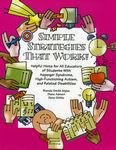
|
Simple Strategies
That Work! Helpful Hints for All Educators of Students with Asperger
Syndrome, High-Functioning Autism, and Related Disabilities.
Brenda Smith Myles, Diane Adreon & Dena Gitlitz. $28.95
SIMPLE STRATEGIES THAT WORK provides ideas and suggestions
that teachers can use to help a student with ASDs and other developmental
delays on the road to success. Looking at problems that arise in
the classroom, the authors discuss how teachers can make adjustments
to accommodate, while not interfering with normal classroom routines.
The book includes tables and boxes for quick reference and clear
meaning. Also included is information on what can cause anxiety
for the autistic/Asperger student, how this can lead to decreased
academic and social performance, decreased attention to task, and
potential increases in behavior problems, and what the teacher can
do to assist.
|
Back to top
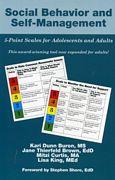
|
Social Behavior and Self-Management:
5-Point Scales for Adolescents and Adults. Kari
Dunn Buron, Jane Thierfeld Brown, Mitzi Curtis & Lisa King, $30.95
Building on the success of
the INCREDIBLE 5-POINT SCALE, by Buron and Curtis, this book also uses
scales as a way of explaining social and emotional concepts to individuals who
have difficulty understanding such information but have a relative strength in
understanding systems. The 5-point scales can be used to increase communication
between the person on the spectrum and their support person. It can increase
self-management skills and, once learned, it can serve as an excelled
self-advocacy tool. As such, it is invaluable at school, on the job and in the
community. |
|
Social Rules for Kids: the Top 100 Social Rules Kids
Need to Succeed. Susan Diamond, $30.95 (ages 7-14)
Many parents are not sure of what to say and do to help
their children improve their social interactions. Social Rules for Kids helps open the door of communication between parent and child by addressing 100
social rules for home, school, and the community. Using simple, easy-to-follow
rules covering topics such as body language, manners, feelings and more, this
book aims to make students' lives easier and more successful by outlining
specific ways to interact with others on a daily basis. |

|
Social Skills Training
for Children and Adolescents with Asperger Syndrome and Social-Communication
Problems. Jed Baker, $52.95 |
Back to top
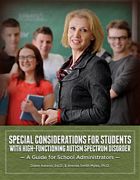
|
Special Considerations for Students with
High-Functioning Autism Spectrum Disorder: a Guide for School Administrators.
Diane Adreon & Brenda Smith Myles, $30.95
School administrators play a key role in creating a
mind-set within their school district, region, or school as to how school
personnel approach various challenges they may encounter when working with
students and families. In many instances, a school administrator can provide
certain accommodations for students with disabilities, as well as guide
decisions regarding how teachers address behavioral challenges. The purpose of
this book is to provide school administrators with useful and practical
suggestions and strategies that can increase student achievement, engagement,
positive behavior, and social skills for high-functioning students on the
spectrum (HF-ASD); help reduce educator stress and frustration; and increase
positive interactions between families and school personnel so that the school
day is more successful for all parties. |
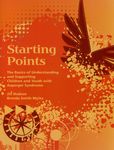
|
Starting Points:
the Basics of Understanding and Supporting Children and Youth with
Asperger Syndrome. Jill Hudson & Brenda Smith Myles,
$19.95 STARTING POINTS offers a variety of
strategies and visual supports that help children on the spectrum
who:
- Have difficulty with abstract concepts
and thoughts
- Have difficulty understanding and
regulating emotions
- Have difficulty recognizing, interpreting,
and empathizing with the emotions of others
- Find it easier to answer questions
with choices versus open-ended questions
- Need cues for how and when to transition
from an activity or place to the next & much more
Starting from the premise that
no two individuals with AS are the same, Hudson and Myles provide
a global perspective of how the core characteristics of AS may appear
separately and/or simultaneously, and how they may manifest themselves
in a variety of situations. |
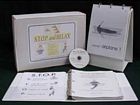
|
S.T.O.P. and
Relax. Louise Goldberg, Sally Miller, Debra Collins &
Daniela Morales, $199.95 S.T.O.P. AND RELAX
is a visual curriculum of guided yoga-based movements and breathing
exercises for students of all ability levels. This program was created
by autism educators to teach students with special needs how to
monitor their anxiety levels and make sense of a very stimulating
environment. The kit contains 46 teacher direction cards; 46 visual
cue cards; a durable display stand for visual cues; easy-to-use
manual for quick implementation; a CD with music, guided relaxation
and breathing and student booklets for generalizing skills. |
Back to top
|
Strategies at
Hand: Quick and Handy Positive Behavior Support Strategies.
Robin Brewer & Tracy Mueller, $21.50
For ease of use, the various sections of this handy
reference are divided by colors and intensity of needs. It
also provides a wide range of behavioral supports divided into Primary,
Secondary and Tertiary Interventions, and can be easily used by
moving from the universal to targeted and finally intensive level
of support based on the student's need. In addition to practical
suggestions for each level, STRATEGIES AT HAND provides a quick
overview of how to conduct a functional behavioral assessment, collect
data and much more. With this flip-book at their fingertips, teachers
will never again have to search for effective behavior management
strategies. |
|
Strategies
at Hand: Quick and Handy Strategies for Working with Students on
the Autism Spectrum. Robin Brewer & Tracy Mueller,
$16.50
STRATEGIES AT HAND features convenient,
easy-to-implement strategies that can be used in all types of educational
settings and situations. This at-your-fingertips tool is broken
down into five color-coded sections that are easy to locate and
use: Learning Environments (classroom, field trips, etc.), Areas
of Student Need (communication, behavior, etc.), Transitions (substitute
teachers, school assemblies, etc.), Alphabetical Explanations of
Terms (functional behavioral assessment, picture communication systems,
etc.), and Resources and References. The bookmark size and unique
binding of Strategies at Hand make it easy to carry around and to
use. |
|
Stuck! Strategies. Janice Carroll & Terry
Ellis Izraelevitz, $27.50
What to do when students get stuck — how to turn
"no" into "let's go" with proactive, positive, supportive
and effective strategies. It doesn't get much better than that! |
|
Students
with Asperger Syndrome: a Guide for College Personnel. Lorraine
Wolf, Jane Thierfeld Brown & G. Ruth Kukiela Bork, $28.50
Timely, practical advice and sound
information on how educators and administrators can best support
college students with Asperger Syndrome and other autism spectrum
disorders. |
Back to top
|
Successful Problem-Solving for
High-Functioning Students with Autism Spectrum Disorders. Kerry Mataya & Penney Owens, $20.95
Many individuals with autism spectrum
disorders (ASD) have difficulty coming up with effective ways to solve
problems. SUCCESSFUL PROBLEM-SOLVING FOR STUDENTS WITH AUTISM SPECTRUM
DISORDERS teaches how to integrate the book's problem-solving chart into
classrooms, homes, and social skills groups to help individuals with ASD to
learn to problem solve effectively. The book uses The Incredible 5-Point
Scale as a resource to get individuals in the right frame of mind. |
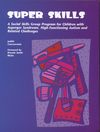
|
Super Skills: a
Social Skills Group Program for Children with Asperger Syndrome, High-Functioning
Autism and Related Challenges. Judith Coucouvanis, $63.95
The title says it all! SUPER SKILLS: A SOCIAL SKILLS
GROUP PROGRAM FOR CHILDREN WITH ASPERGER SYNDROME, HIGH-FUNCTIONING
AUTISM AND RELATED CHALLENGES is SUPER at many levels. Based on
a thorough and comprehensive understanding of the unique characteristics
of individuals with ASD, Judy Coucouvanis presents 30 lessons grouped
under four types of skills necessary for social success: fundamental
skills, social initiation skills, getting along with others, and
social response skills. Each lesson is highly structured and organized,
making it easy for even inexperienced teachers and other group leaders
to follow and implement successfully. A series of practical checklists
and other instruments provide a solid foundation for assessing students'
social skills levels and subsequent planning. |
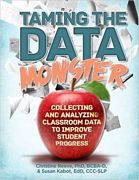
|
Taming The Data Monster: Collecting and Analyzing
Classroom Data to Improve Student Progress. Christine Reeve & Susan
Kabot, $40.95
Faced with increasing demands for accountability, teachers are having to base
their instructional decisions and choice of interventions on data on student
performance. This book shows how to make this otherwise daunting task much more
manageable by means of case studies and countless evidence-based forms and
graphs. Although this book often refers to students and classrooms, the
data collection techniques are applicable to a wide range of environments,
including clinics, job-training and actual job sites, and homes. In
addition, the data collection tools and procedures are relevant for use with a
wide range of ages, from toddlers to adults. |
Back to top
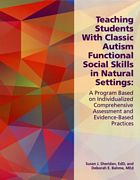
|
Teaching Students with Classic Autism
Functional Social Skills in Natural Settings. Susan
Sheridan & Deborah Bahme, $26.95
A program based on individualized
comprehensive assessment and evidence-based practices.
This highly practical book guides
teachers and other practitioners in developing and implementing comprehensive
social skills programs for individuals with classic autism. This program was
developed specifically for students with classic features of autism, who tend
to learn best by participating in activities they find interesting, engaging,
and part of their daily lives. As a result, the social skills are embedded in
motivating lessons in real-life social situations, involving such things as
learning to do something nice for others, working on a classroom project, or
waiting in a cafeteria line. To make this well-crafted functional social skills
curriculum even more relevant, it includes a comprehensive, yet easy-to-use
assessment tool tied to IEP development using evidence-based practices. |
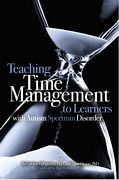
|
Teaching Time Management to Learners with Autism
Spectrum Disorder. Caroline DiPipi-Hoy & Daniel Steere, $31.50
An individual with ASD may quickly learn time-telling
skills; however, simply being able to tell time does not necessarily lead to
time-management skills. This practical book provides the tools necessary to
move beyond time identification, and teach learners how to use time in a way
that promotes independence.
Teaching Time Management to Learners with Autism
Spectrum Disorder presents ways to facilitate time-management skills for
learners across the lifespan, as a skill that can be developed from early childhood
through the adult years. |
Back to top
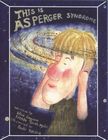
|
This is Asperger Syndrome.
Elisa Gagnon & Brenda Smith Myles, illustrated by Sachi Tahara,
$17.95 |
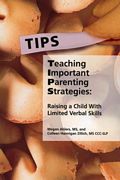
|
TIPS — Teaching
Important Parenting Strategies: Raising a Child with Limited Verbal Skills. Megan
Ahlers & Colleen Hannigan Zillich, $30.95
TIPS — TEACHING IMPORTANT PARENTING
STRATEGIES is an excellent resource for anyone raising a young child with
limited communication skills and/or challenging behaviors. Based on questions
and answers that parents and caregivers have asked the authors throughout the
years, TIPS may be read in its entirety, or readers can skip around
among individual questions and answers. Regardless, the book can be used as a
reference for finding practical, user-friendly solutions to common universal
challenges encountered by parents and caregivers, including communication,
behavior, technology, community outings, and sensory needs. All answers follow
best practice and evidence-based strategies. |
|
Visual Thinking
Strategies for Individuals with Autism Spectrum Disorders: the Language
of Pictures. Ellyn Lucas Arwood, Carole Kaulitz & Mabel
Brown, $36.95
Visuals of all kinds (photographs, checklists, line
drawings, cartoons, flowcharts, stick figures, etc.) are commonly
used as supports for individuals on the autism spectrum who tend
to think and learn visually. However, not all visuals are created
equal and, therefore, visuals don't all work equally well. This
companion to LEARNING WITH A VISUAL BRAIN IN AN AUDITORY WORLD helps
the reader understand how to match the developmental levels of pictures
and visuals to the developmental level of the person looking at
the visual. In this way, appropriate visuals provide the language
development for children with autism spectrum disorders. Drawing
from their experience with children and youth for decades, the authors
also show how effective communication can help reduce the confusion
and anxiety that often lead to behavioral outbursts. |
Back to top
|
A Week of Switching, Shifting, and
Stretching: How to Make My Thinking More Flexible. Lauren
Kerstein, $24.95
This picture book assists children on
the autism spectrum, and any child for that matter, in examining their
black-and-white thinking in order to begin to think more flexibly — rainbow
thinking. Using repeated rhymes and illustrations, the child begins to
recognize that the more flexible his thinking is, the better he is able to cope
with the challenges that life inevitably brings, ultimately, leading to fewer
tantrums and meltdowns. |
|
When My Worries Get Too Big! A
Relaxation Book for Children Who Live with Anxiety, 2nd Edition. Kari Dunn Buron, $27.95
Worry and anxiety are on an upswing. In
fact, anxiety is the most frequent of all mental disorders in children. High
levels of stress and big emotions related to social situations, sensory issues,
or general frustration are common in children who live with anxiety. Such
stress can lead to a loss of control, resulting in aggressive behavior, such as
screaming, throwing things or even hurting someone. Prolonged anxiety can also
seriously impact success in academic achievement and cause children to avoid
social and extracurricular activities. Now with a special section on
evidence-based teaching activities for parents and teachers alike, this
bestselling children’s classic just became even better and more relevant.
Engaging and easy to read, this illustrated children’s book is filled with
opportunities for children to participate in developing their own self-calming
strategies. Children who use the simple strategies in this charming book will be
able to relax and focus on work — or play! |
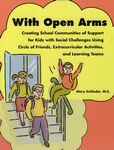
|
With Open Arms: Creating School Communities
of Support for Kids with Social Challenges Using Circle of Friends,
Extracurricular Activities, and Learning Teams. Mary Schlieder,
$37.50
WITH OPEN ARMS: CREATING SCHOOL COMMUNITIES OF SUPPORT
FOR SOCIALLY CHALLENGED KIDS provides practical, easy-to-use techniques
for even the busiest school personnel. Using familiar case studies
in an easy-to-read format, this manual provides step-by-step instructions
for how to implement Circles of Friends, participation in extracurricular
activities, and professional Learning Teams to create both accepting
peers and staff. Written by a teacher ‘in the trenches,’ the book
includes reproducible worksheets, Learning Team and Book Club study
guides, Circle meeting forms and activities, charts, and checklists... everything you need to create your own supportive community for
the kids you care about. |
Back to top
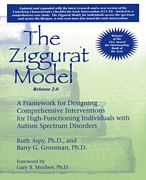
|
The
Ziggurat Model: a Framework for Designing Comprehensive Interventions
for Individuals with High-Functioning Autism and Asperger Syndrome,
Release 2.0. Ruth Aspy, & Barry Grossman, $74.95 (Includes
Individual Strengths and Skills Inventory (ISSI) and a special section
on Ziggurat-CAPS Integration)
Also:
The Ziggurat Model, Textbook Edition: Desigining
Comprehensive Interventions for Individuals with High-Functioning
Autism and Asperger Syndrome. Ruth Aspy, & Barry Grossman,
$73.95
UCC-CL: Underlying Characteristics Checklist
Manual, a Needs Assessment Tool to Facilitate Intervention Design
for Individuals with Autism Spectrum Disorders. Ruth Aspy
& Barry Grossman, $35.95. Includes 20 copies of assessment tool.
UCC-CL French Edition, $26.50
UCC-HF: Underlying Characteristics Checklist
Manual, a Needs Assessment Tool to Facilitate Intervention Design
for Individuals with Autism Spectrum Disorders. Ruth Aspy
& Barry Grossman, $35.95. Includes 20 copies of assessment tool.
UCC-HF French Edition, $26.50
UCC-EI: Underlying Characteristics Checklist
- Early Intervention (3 months through 72 months). Ruth
Aspy, Kathleen Ann Quill& Barry Grossman, $26.50 Includes 20
copies of assessment tool.
Underlying
Characteristics Checklist (UCC) Manual, CD-ROM.
Ruth Aspy, Barry Grossman & Kathleen Ann Quill, $20.95
Developed as a component
of the Ziggurat Model, the Underlying Characteristics Checklist (UCC) is an
informal, non-standardized assessment tool designed to identify characteristics
across a number of domains associated with ASD. The UCC USER MANUAL outlines
directions for using all 3 Underlying Characteristic Checklists: UCC-CL,
UCC-HF, and the UCC-EI. The UCC and the Ziggurat Model in tandem lead to a
program that is based on individual needs and uses the best practices in the field.
The CD-ROM also includes the Individual Strengths and Skills Inventory found in
the Ziggurat Model book. |
|
Back to top

From Behavior Analysts
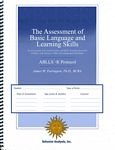
|
The Assessment
of Basic Language and Learning Skills, Revised (ABLLS-R).
James Partington, $94.95; Protocol only, $58.95
The Assessment of Basic Language
and Learning Skills (The ABLLS) is an assessment, curriculum
guide, and skills tracking system for children with language delays.
The ABLLS contains a task analysis of the many skills necessary
to communicate successfully and to learn from everyday experiences.
The ABLLS is comprised of two separate documents: The ABLLS Scoring
Instructions and IEP Development Guide (The ABLLS Guide), and The
ABLLS Protocol that is used to record scores for each child. The
new revised version of the ABLLS includes many new task items that
were not included in the previous edition. There are numerous changes
in the descriptions and criterion for individual task items, as
well as in the sequencing of many task items. A review of the changes
can be found in the ABLLS Changes Chart. Individuals who have used
the earlier version are advised to review the information regarding
the changes.
|

|
WebABLLS 2.0
WebABLLS is a web-based platform for the Assessment of Basic Language and Learning Skills-Revised (ABLLS-R) — an assessment, curriculum guide, and skills tracking system that mirrors the ABLLSR in an electronic format.
WebABLLS incorporates the latest updates and revisions from ABLLS-R and provides an innovative level of program data management.
For more information on the WebABLLS and how to order, please see our WebABLLS 2.0 page here. |

|
Getting Started: Developing Critical Learning Skills
for Children on the Autism Spectrum — A Step-By-Step Guide to Further the
Development of Children with Minimal Language Skills. James
Partington, $57.95
This book is a “must have” for every parent or educator
of a child who has no — or very limited — language skills. It provides
evidence-based ABA/VB methodology, written in non-technical and easy to
understand terms. It provides critical information on where to start and
how to teach initial skills to children with minimal language skills. It
provides the rationale for teaching six critical learning skills and
the procedures necessary to develop them. Professionals have identified
these skills as an important basic foundation for a child’s overall
development.
Step-by-step instructions allow a parent or teacher to
implement training and track the child’s acquisition of these important
skills. All of the strategies in this book are linked to the skills in
the ABLLS-R®. In addition, it provides the reader with strategies to
motivate the child to participate in those learning activities as well as
identify appropriate goals. |
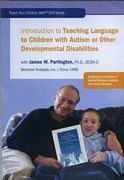
|
Introduction to Teaching
Language to Children with Autism or Other Developmental Disabilities.
James Partington, $97.95 DVD
This DVD provides an overview of B. F. Skinner’s functional analysis of language to parents, educators, and other practitioners. A review of the primary types of expressive language skills (verbal operants) is included along with video clip demonstrations of effective teaching methods. Viewers will learn how to assess a child’s language abilities, and how to design and implement an appropriate language intervention program. A major emphasis is placed on identifying methods to enhance and utilize motivational variables to teach language in both structured teaching sessions and in daily activities. Techniques for coordinating the ongoing decision making necessary for effective language intervention and methods of data collection and tracking are also presented. |
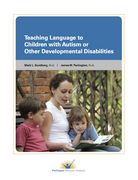
|
Teaching Language to Children with Autism or Other
Developmental Disabilities. Mark Sundberg & James Partington, $59.95
Most children with autism or other developmental
disabilities experience severe language delays or disorders. Teaching language
to these children can be quite a challenge to parents and professionals. This
book presents a state-of-the-art language assessment and intervention program
based on B.F. Skinner's behavioral analysis of language, and the extensive body
of empirical research that supports Skinner's analysis.
The first section of the book provides information regarding preparation for
language intervention, including a brief language assessment and a system to
interpret the assessment in order to determine the best place to start
intervention for an individual child. Section One also contains a chapter on
augmentative communication and information on how to decide if it is necessary;
and if so, which type might be the best for an individual child. Section Two
focuses on the development of initial communication skills for nonverbal
children, and Section Three focuses on teaching more advanced language and
social skills. Section Four presents issues relevant to the implementation of a
language program in a child's natural and school environments. In addition,
there are a variety of data sheets and skills tracking forms located throughout
the book. |
Back to top

Hawaii Early Learning Profile Resources (HELP)
HELP Activity Guide (0-3):
Comprehensive Strategies Essential for Planning Intervention,
$57.95 Product # 152
This very popular and widely-used resource takes you easily beyond assessment to offer the important next step — thousands of task-analyzed, practical curriculum activities and intervention strategies indexed by the 685 HELP skills. Offering up to ten activities/strategies per skill, this important tool includes definitions for each skill, illustrations and cross references to skills in other developmental areas, a glossary, and a list of commercial materials. |
|
HELP at Home (0-3), 2nd Edition, $146.95 Product # 156
535 ready-to-use reproducible handouts, with links assessment directly to intervention. Includes thousands of "at home" activities with warm photos and practical suggestions. |
HELP Charts (0-3), $5.50 Product # 150
Facilitates and helps communication with parents and involving them in their child's plan. The Charts are a set of 3 different sheets displaying the 685 HELP developmental skills as a horizontal continuum for the six domains of Cognitive, Language, Gross Motor, Fine Motor, Social, and Self-Help. Each sheet covers two of the six developmental domains. The clear format makes it easy to review mastery of skills, target objectives, and chart and track progress. |
Back to top
HELP Checklist (0-3), $5.50 Product # 151
Covers the same six developmental domains/areas as the HELP Charts and the HELP Strands, but in a different format. The Checklist groups the 685 HELP skills in the six domains according to age level, with columns for easy recording of assessment dates, progress information, and comments. Helpful for assessment of children who are developing normally or considered "at-risk."
|
|
HELP Family Centred Interview: Birth to Three, $3.15 Product # 157
Facilitates your family interview and assessment
process — a listing of 80 key open-ended questions and prompts
based on over 400 sample questions from Inside HELP — in a
simple format you can use directly with parents. Helps you focus
on family-centered priorities and outcomes for more effective intervention. |
HELP Strands (0-3): Curriculum-Based
Assessment, $5.75 Product # 158
Offers key developmental assessment framework — skills are "stranded" by interrelated concepts. Makes for easier identification and selection of "next steps" — target skills.
HELP Strands 0-3 PLUS: Curriculum-Based Assessment, $6.25 Product # 158-P
HELP STRANDS 0-3 PLUS was developed to
support the needs of Birth to Three programs with three-year-old children who
have not yet “graduated”, or are advanced beyond three years in some areas of
development. HELP STRANDS 0-3 PLUS extends the range of the HELP Strands 0-3 by
adding 36-48 month-range skills form the complementary but separate HELP
Strands 3-6. |
Back to top
HELP 3-6 Activities at Home, 2nd Edition,
$98.95 Product # 656
Provides reproducible, ready-to use parent handouts to help you work with and support parents as they work on behaviors and skills at home, in conjunction with your program planning. |
|
HELP 3-6 Assessment Manual, 2nd Edition, $89.95 Product # 659
Comprehensive assessment procedures, definitions, materials lists in one easy-to-use tool. Covers 585 developmental behaviors/skills arranged in 47 developmental Strands that seamlessly extend HELP 0-3.
|
HELP 3-6 Assessment Strands: Curriculum-Based
Assessment, 2nd Edition,
$5.50 Product # 658
The HELP 3-6 behaviors/skills follow a "normal" developmental sequence within strands and are applicable to all children. New format for easier developmental assessment.
- Groups the 585 HELP 3-6 behaviors/skills into 47 "concept-based" strands.
- Provides columns for recording assessment dates, credit, ongoing observations and notes.
- Includes a definition for each behavior/skill to help with continuity in applying credit.
- Three of the strands are for use with children who have special needs.
|
Back to top
HELP 3-6 Curriculum Guide, 2nd Edition,
$62.95 Product # 652
Instructional activities, definitions, materials linked directly to the assessment behaviors/skills.
- Makes curriculum planning more practical and efficient
- Links instruction directly to assessment
- Thousands of effective instructional activities.
|
|
HELP 3-6 Charts, 2nd Edition, $5.50 Product # 650
The Charts are a set of 3 different sheets displaying the HELP 3-6 behaviors/skills as a horizontal continuum. The Charts cover the six developmental domains: Cognitive, Language, Gross Motor, Fine Motor, Social, and Self-Help. Each sheet covers two of the six developmental domains.
- Provides a complete "visual" developmental profile.
- Helpful for assessment of children who are developing normally or considered "at-risk."
- Convenient for reviewing and tracking behavior/skills by age.
|
HELP 3-6 Checklist: Curriculum-Based
Assessment, 2nd Edition,
$5.50 Product # 651
Facilitates your focus on a child's strengths, as well as needs, provides adaptations for assessing each behavior/skill, and promotes high expectations for all children. The Checklist covers the six developmental domains: Cognitive, Language, Gross Motor, Fine Motor, Social-Emotional, and Self Help. Follows a "normal" developmental sequence within strands and are applicable to all children. Three of the strands are for use with children who have special needs. |
Back to top
HELP When the Parent has Disabilities.
Stephanie Parks, $62.95 Product # 153
This unique resource offers thousands of activities and training techniques for directly involving parents who are blind, deaf, have physical disabilities, or have cognitive or developmental deficits. It is cross-referenced to the HELP skills (ages birth-2 years), and offers special adaptations for parent training and involvement. A valuable tool, it provides an effective basis for the involvement of all parents. |
|
Inside HELP: Administration and Reference Manual for the
Hawaii Early Learning Profile. Stephanie Parks, $106.95 Product # 159
This comprehensive administration manual is essential for the proper use of the HELP materials, and it offers a wealth of developmental assessment procedures for using HELP — the Hawaii Early Learning Profile (0-3) — for effective curriculum-based assessment, planning, therapy, and intervention.
|
Back to top

From LactNews Press
|
|
The Breastfeeding Atlas, 6th Edition. Barbara Wilson-Clay & Kay Hoover, $117.95
The Breastfeeding Atlas, 6th edition has been substantially re-written to reflect the most current research and best, evidence-based clinical practices. It also reflects the practical experience of Barbara Wilson-Clay, and Kay Hoover, both Fellows of the International Lactation Consultant Association, who have each been assisting mothers and babies for 30 years. New photos have been added, as well as an entirely new chapter, Breastfeeding in Emergencies. A must-have text for students, candidates for the IBLCE exam, and practitioners working in maternal-child health fields.
A new study identifies The Breastfeeding Atlas as a tool that helps candidates pass the international lactation certification exam: “Despite not being translated into Croatian or Slovenian, the Breastfeeding Atlas proved to be more commonly used as a study material by respondents who passed [the IBLCE exam].” — Grkovic Z, Bosnjak A, Buljan I, et al. |
|
|
The Diaper Diary (Diapers of the Breastfed Baby). Kay Hoover & Barbara Wilson-Clay, $22.95/pad (pad has 50 tear-off sheets)
The Diaper Diary (Diapers of the Breastfed Baby) is a hand-out for nursing mothers that shows the changes in the stool of a breastfeeding infant during the first week postpartum. It also contains photos of stools that indicate a need for follow up with a mother’s health care provider. The text is written at a 4th grade reading level. The reverse side provides a log for recording the number of stools and wet diapers on a daily basis for the first week postpartum. Each Diaper Diary pad has 50 tear-off sheets with photos on the front and an easy-to-use log form on the back. |
Back to top

From Model Me Kids
|
The Model Me Kids Video Series for
Modeling Social Skills DVDs
THE MODEL ME KIDS VIDEO SERIES FOR
MODELING SOCIAL SKILLS was created for children and youth with autism, Asperger
syndrome, nonverbal learning disorders, social anxiety, learning disabilities
and other developmental delays. The DVDs demonstrate a wide variety of social
skills and are great teaching tools for visual learners.
MODEL ME KIDS TEACHING MANUALS AND STUDENT
WORKBOOKS complement the video modeling DVDs and help extend the lessons taught
in the live-action DVDs. These resources help teach social skills at home, in a
classroom, social skills group, or other teaching setting. The Teaching Manual
comes complete with lesson plans and the Student Workbook has numerous social
skills worksheets and activities. Sold separately from the DVDs. |
Teachers - Speech Language Pathologists -
School Psychologists - Autism Service Providers
Model Me Kids® Autism Training Workshops
Model Me Kids® now offers professional training workshops. Schedule an in-service workshop for your school, designed to teach staff how to implement social skills training for children with autism using video modeling. For more information, or to schedule a training workshop, please contact: [email protected]
Learn More |
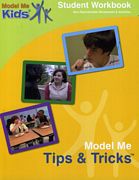
|
|
Model
Me Interactive™: Practicing Conversation CD-ROM, $71.95 (Ages 7-13)
MODEL ME INTERACTIVE™: PRACTICING
CONVERSATION combines video modeling teaching tools with the interactive
capability of software. First, video models a conversation between children.
Then, the student practices the conversation using a webcam. The practice
conversation is recorded and a feedback area allows teachers to comment on and
grade a student's recordings.
The interactive conversation can be prompted
with text or this feature may be turned off once the user becomes familiar with
the lines. The text prompts may be changed by the user for an endless number of
possible responses to the conversation prompts. The software is intuitive and
easy to use. Clear text buttons allow for navigation by young users. |
|
Ages 15 to 21:
Model Me Job Skills. Watch as young adults model
social skills helpful for gaining and maintaining employment — from interviews
and greetings, to understanding rules and workplace expectations. The DVD comes
with bonus software that combines video modeling teaching tools with
the interactive capability of software, allowing a student to practice a
conversation using a webcam. DVD, $49.95 (80 minutes) |
|
Ages 9 to 17:
Model Me Confidence & Bullying Prevention. Modelling skills to prevent bullying and build self-esteem. DVD, $42.95 (63 minutes); Teaching Manual and Student Workbook Set, $72.95; Teaching Manual & 4 Student Workbooks $102.95; 5 Student Workbooks $102.95
Model Me Conversation Cues. Modelling conversation skills. DVD, $40.95 (68 minutes); Teaching Manual and Student Workbook Set, $72.95; Teaching Manual & 4 Student Workbooks $102.95; 5 Student Workbooks $102.95
Model Me Friendship. Modelling how to initiate and maintain friendships. DVD, $42.95 (75 minutes); Teaching Manual and Student Workbook Set, $72.95; Teaching Manual & 4 Student Workbooks $102.95; 5 Student Workbooks $102.95
Model Me Movement, Balance & Calming. Movement activities developed by an Occupational Therapist to improve balance, increase core strength, and promote self-calming. DVD, $42.95 (60 minutes)
Model Me Organization & Motivation. Modelling skills for staying organized and persisting. DVD, $45.00 (63 minutes); Teaching Manual and Student Workbook Set, $72.95; Teaching Manual & 4 Student Workbooks $102.95; 5 Student Workbooks $102.95
Model Me Tips and Tricks. Demonstrating social skills tips and tricks. DVD, $42.95 (67 minutes); Teaching Manual and Student Workbook Set, $72.95; Teaching Manual & 4 Student Workbooks $102.95; 5 Student Workbooks $102.95
Model Me Yoga demonstrates yoga activities that
promote the social and emotional development of children ages 7-17. Developed
to help address challenges with attention, Autism Spectrum Disorders, social
skills, self-regulation, learning, and low muscle tone, this DVD can be used in
classrooms, camps, and other group settings as well as in-home. DVD,
$42.95 (153 minutes) |
|
|
|
|
|
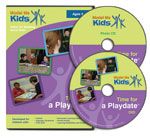
|
Ages 5 to 12:
Model Me I Can Do It! Presents social skills in the context of challenging circumstances. It features elementary school-aged children demonstrating appropriate behavior in a variety of difficult situations. DVD, $42.95 (53 minutes); Teaching Manual and Student Workbook Set, $72.95; Teaching Manual & 4 Student Workbooks $104.95; 5 Student Workbooks $104.95
Model Me Time for a Playdate. Presents social skills in the context of several playmates. It features elementary school-aged children demonstrating appropriate social skills on a playdate. DVD, $42.95 (67 minutes); Teaching Manual and Student Workbook Set, $72.95; Teaching Manual & 4 Student Workbooks $102.95; 5 Student Workbooks $102.95
Model Me Time for School. Presents social skills in the context of school. It features elementary school-aged children demonstrating appropriate social skills in the classroom, library, on the playground, and in the hallway. DVD, $42.95 (61 minutes); Teaching Manual and Student Workbook Set, $72.95; Teaching Manual & 4 Student Workbooks $102.95; 5 Student Workbooks $102.95
Ages 3 to 14:
Model Me Airplane. Presents the essential elements
of air travel. Follow Owen as he goes through the airport, security, and
boarding. Then join him on the plane as he listens to the flight attendant,
buckles his seatbelt, and enjoys the plane ride. DVD, $35.95 (50 minutes)
Ages 2 to 8:
Model Me Faces and Emotions. Watch as young children demonstrate a wide range of faces and emotions. This is a great teaching tool for visual learners. DVD, $35.95 (27 minutes)
Model Me Going Places. Models appropriate behavior in community locations including the hairdresser, grocery store, dentist, doctor, mall, and more. DVD, $35.95 (42 minutes) |
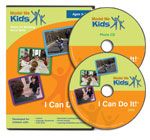
|

|
|
|
|
|
|
|
Model Me Training: Practical Strategies
for Using Video Modeling for Teaching Social Skills to Children with Autism. Elizabeth Delsandro & Jennifer Cerbasi, $40.95 (2 DVD set)
This workshop examines video modeling as
an evidence-based method of improving social skills in children with autism
spectrum disorder (ASD). Children with ASD often have social skills
deficits that interfere with success. Video modeling has been found to be an
efficient and effective method of teaching social skills to children with ASD. This
DVD workshop addresses how to implement a video modeling program, pairing video
modeling with other social skills training approaches, and strategies for
generalization of skills.
This recorded video of our live
professional training workshop is for teachers, therapists, paraprofessionals,
speech language pathologists, and Autism service providers. Run Time: DVD 1
approx. 83 minutes, DVD 2 approx. 64 minutes |
Back to top

From Tasks Galore
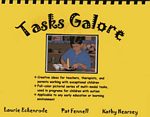
|
Tasks Galore, Laurie
Eckenrode, Pat Fennell & Kathy Hearsey, $62.95
Creative ideas for teachers, therapists, and parents working with
exceptional children. Full-color pictorial series of multi-modal tasks,
used in programs for children with autism. Applicable to any early
education or learning environment.
The authors are all current or former employees of TEACCH,
and together have over sixty years of experience working with exceptional
children and adults. |
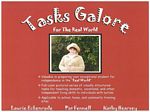
|
Tasks Galore for the Real World.
Kathy Hearsey, Laurie Eckenrode & Pat Fennell, $62.95
Tasks Galore for the Real World,
the second book in the Tasks Galore set, is a valuable tool
for preparing older elementary students, adolescents, and adults
for independence in the home, school, community, or workplace. Forty-three
colorful photo pages present task ideas in these categories:
- Developing and Teaching Functional
Goals
- Domestic Skills
- Vocational Skills
- Independent Living Skills
- Job Sites & School Transition
Ideas
|
|
Tasks Galore
Let’s Play: Structured Steps to Social Engagement and Symbolic
Play. Laurie Eckenrode, Kathy Hearsey, Pat Fennell & Beth
Reynolds, $75.95
The fourth book in the popular Tasks
Galore resource series for parents, teachers and therapists
utilizes play as the program foundation for learning. These
strategies are based on evolving evidence that teaching play
skills can increase young children’s symbolic understanding
and, thus, have an impact on their imitation, language and
social skills. |
Back to top
|
Tasks Galore Literature-Based
Thematic Units. Laurie Eckenrode & Pat Fennell,
$75.50
TASKS GALORE: LITERATURE-BASED THEMATIC
UNITS, the fifth book in the popular resource series for parents, teachers, and
therapists, integrates instruction across core curriculum areas by utilizing
multisensory learning.
Using the storybook, I’M HUNGRY, I’M HUNGRY, WHAT SHALL I DO? as a guide
for creating literature-based thematic units, the authors have designed
hands-on activities for use with young learners and students with special
needs. The strategies employed encourage responsiveness to literature
while enhancing vocabulary and language. Tasks illustrate how to make
learning more meaningful by:
- using organizational strategies and visual cues
- connecting themes to everyday experiences
- adapting skills for 21st century learning, and
- individualizing for differing learning styles
|
|
Tasks Galore: Making Groups Meaningful. Laurie
Eckenrode, Pat Fennell & Kathy Hearsey, $68.95
Tasks Galore: Making Groups Meaningful aids
teachers, parents and therapists in applying structured teaching techniques
within classroom groups, school specials, and even parties! Designing
meaningful home and school group activities involves integrating IEP goals,
individualizing structure and communication, and teaching rules. Tasks
Galore: Making Groups Meaningful includes full color photos illustrating
structured groups. |

From Social Thinking
(A 10% discount applies to all professional-use purchases of Social Thinking publications)
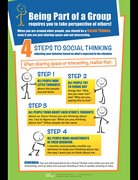
|
Being Part of a Group Poster. $15.95* (3rd Grade and up) *a 10% discount applies to all professional-use purchases
of Social Thinking publications.
The Being Part of a Group poster encourages greater awareness of how all people in a group need to be mindful of each other's presence, intentions, and thoughts. In doing so, students can learn to monitor and possibly modify their own behavior to keep people thinking about them the way they want them to. The poster also provides the opportunity for teachers and parents to talk with students about each person's responsibility to the larger group.
This poster is also sold as part of the Social Thinking - Four Posters for the Classroom & Treatment Room set. |
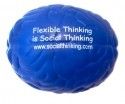
|
Brain (Foam Rubber). $5.95
Squeezing these small, blue foam rubber brains encourages kids to think more flexibly and abstractly about the size of their problems and the choices they are making. Used in lessons that encourage flexible thinking, including those in the Superflex comics and Thinking about YOU Thinking about ME, the brains offer a fun way to think about their social thinking and related skills. "Social Thinking is Flexible Thinking" is inscribed on the brains to reinforce learning.
|
Back to top
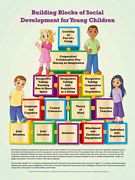
|
Building Blocks of Social Development for Young
Children – Poster. $12.95* *a 10% discount applies to all professional-use purchases
of Social Thinking publications.
For parents and professionals. The Building
Blocks of Social Development poster is a companion product to the Social
Thinking® early learner curriculum The Incredible Flexible You™. It
shows the developmental building blocks that synergistically work together and
result in a fully functional and flexible, kindergarten-ready child who
possesses the social problem-solving skills needed to play with others and
learn in a group. Excellent tool during IEP/treatment meetings and staff
discussions to guide a deeper understanding of the social learning process in
young children. |
|
Good Intentions Are Not Good Enough: a Guidebook for
Anyone Who Feels Socially Out of Step with Others. Michelle Garcia Winner
& Pamela Crooke, $36.95* *a 10% discount applies to all professional-use purchases
of Social Thinking publications.
This 200+ page book is a primer about the social mind in
the workplace, but the concepts and strategies are equally applicable in all
areas of life. It’s largely based on the authors’ years of clinical experience
working with adults who struggle socially, but may or may not identify their
problems with a specific diagnosis. Many are highly intelligent and skilled
employees who find it difficult to decipher the often nuanced social
underpinnings that are part of daily life, on or off the job. Adults with
social learning challenges often need information about social emotional
relationships broken down and explained in a way that can help them build
skills and understanding, one step at a time. This book does just that — it is
a constructive and detailed guide to help adults learn how to do the “social
dance” in order to build stronger relationships at work and beyond. Remember,
good intentions aren’t good enough! Attempting to interpret others’ thoughts
and emotions is as much a part of the workday as is doing our actual jobs. By
learning to think socially we can change our behavior to directly affect how we
are perceived and treated.
Although the content is geared to the adult with social
emotional challenges, this is a great source of information for people working
in HR departments to better understand social challenges and how to guide and
coach employees with these challenges.
Note: Previously published as Social Thinking at Work:
Why Should I Care? our new incarnation of the book is a title and cover
change only. Content inside the book is the same. |
Back to top
|
I Get It! Building Social Thinking and Reading Comprehension through Book Chats. Audra Jensen, $35.95* *a 10% discount applies to all professional-use purchases
of Social Thinking publications.
Reading is more that being able to decode words and sentences. True understanding depends on social thinking ability as well as language comprehension. Audra Jensen illustrates the relationship between social thinking and reading comprehension and offers a positive, practical approach to helping children learn to read for meaning. |

|
Inside Out: What Makes a Person with Social Cognitive Deficits Tick? Michelle Garcia Winner, $37.95* *a 10% discount applies to all professional-use purchases
of Social Thinking publications.
For professionals and parents to use with all ages. This book is where to start to learn more about how social problems connect to academic problems, such as reading comprehension and written expression. The book introduces Michelle's ILAUGH model, that helps to pinpoint specific challenges. For ages K-adulthood grade and beyond, this book also provides insight on what information we expect students to develop "naturally" to become strong learners. |
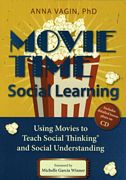
|
Movie Time Social Learning. Anna Vagin, $42.95* *a 10% discount applies to all professional-use purchases
of Social Thinking publications.
One of the greatest challenges in teaching social
thinking is finding interesting, imaginative, and enjoyable ways for students
of all ages to study complex social situations. Movie Time Social
Learning takes an activity many students already love — watching
movies — and uses it as a springboard to study the intricacies of social
interaction. By hitting the pause button, we freeze social situations and give
students the all-so-valuable extra time to read context, interpret thoughts,
feelings and plans, make predictions about social behavior, and formulate
narrative language to discuss social interactions.
Movie Time Social Learning incorporates the
concepts, vocabulary, and strategies that are at the heart of Michelle Garcia
Winner’s Social Thinking framework. The book comes with a CD that includes all
seven lesson plans as well as ready-to-print templates, handouts, and letters. |
Back to top
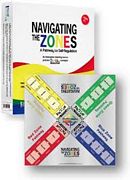
|
Navigating the
Zones: a Pathway to Self-Regulation. Leah Kuypers,
Terri Rossman & Elizabeth Sautter, $77.95* (ages 8-10;
11-13; 14-18; Young Adult) *a 10% discount applies to all professional-use purchases
of Social Thinking publications.
Navigating The
Zones is an interactive teaching tool designed to extend Leah Kuyper’s
original teachings as described in the book The
Zones of Regulation®. It engages participants in a problem-solving process
at the heart of emotional self-regulation — while learning and collaborating
along the way.
It walks participants through the “Zones Pathway” — a
visual, sequential, and concrete road map that helps structure participants’
thinking and processing about the problem-solving sequence that is at the
center of emotional self-regulation. This three-step process involves thinking
about a Situation (where are we, who are we with?), thinking about and
interpreting the Feeling we experience in response to the situation, and
thinking about a Tool or strategy we can use to help us navigate the situation
in an expected way. Group collaboration and problem solving is a significant
part of the journey in Navigating The
Zones. Participants work together, under the guidance of the Adult Facilitator,
to support each other and reach a shared goal. They can offer each other help,
ask questions, suggests tools and strategies, and more — so that as a team,
everyone is successful and the learning is rich!
Materials are adaptable to the learning needs of
participants. This flexible teaching tool can be used in a therapeutic or
non-therapeutic setting, in a classroom or a living room, by parents,
educators, aides, counselors, clinical therapists, behaviorists, psychologists,
social workers, etc.
N.B. Adults (and participants) must already have a strong
working knowledge of the concepts and vocabulary in The Zones of Regulation curriculum book to use this product
successfully. Navigating The Zones is
NOT intended to be a stand-alone tool to teach The Zones of Regulation framework. Navigating The Zones highlights a few core concepts in the book,
but does not begin to tackle all concepts taught. |
|
|
Navigating the Zones®: Advanced Extension Pack
and Game Cards for Tweens, Teens, and Adults. Leah Kuypers, Terri Rossman
& Elizabeth Sautter, $37.50* (Ages 8-10; 11-13; 14-18; Young Adult)*a 10% discount applies to all professional-use purchases
of Social Thinking publications.
If you’ve been using the game Navigating the Zones,
integrate the Advanced Extension Pack and Game Cards to help more sophisticated
thinkers (age 10+) further develop their problem solving and self-regulation
skills. Add these advanced cards to the Navigating The Zones cooperative
game to introduce three additional levels of play — including competitive game
play! The Advanced Extension Pack provides more complex and nuanced Situation
and Feeling Cards and encourages more flexible, strategic thinking by
introducing Wild Cards, Trade-A-Cards, and more. Levels of Team Engagement: Use
Navigating The Zones plus the Advanced Extension Pack to access four levels of
team engagement, each advancing in complexity to help students practice and
develop stronger self-regulation skills as they move from collaborative to
competitive game play. These levels are sequential and should be taught in
order. |
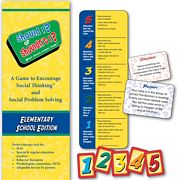
|
Should I or Shouldn't I? A Game to Encourage Social
Thinking and Social Problem Solving. Dominique
Baudry, $39.95* (Elementary School Edition)*a 10% discount applies to all professional-use purchases
of Social Thinking publications.
SHOULD I OR SHOULDN’T I — ELEMENTARY EDITION is a
fun way for children to explore a variety of social behaviors from other
people’s perspectives. Players think about their own responses to various
situations posed on Prompt and Challenge cards, rate them on a 5-point scale,
and then learn how their choices match up (or don’t) with those of the other
players. Questions address a wide variety of age-related situations at school,
at home, at a friend’s home, and in community settings. |
Back to top
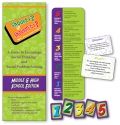
|
Should I or Shouldn't
I? ™ A Game to Encourage Social Thinking and Social Problem
Solving! Dominique Baudry, $38.95* (Middle & High School
Edition) *a 10% discount applies to all professional-use purchases
of Social Thinking publications.
This adaptable game encourages
players to think about their own behavior choices and then compare how
their perceptions match (or don’t) those of the other players. It revolves
around the idea of perspective taking — being able to think about others, their
thoughts, feelings, and behaviors, and how this interrelationship plays out in
social situations. The game is based on the Social Thinking concepts and
vocabulary introduced by Michelle Garcia Winner and outlined in her many books
and articles on the topic. |

|
Should I or Shouldn't I? Elementary School Edition
Expansion Pack. Dominique Baudry, $25.95
Should I or Shouldn't I? Middle & High School
Edition Expansion Pack. Dominique Baudry, $25.95
Double your playing fun with the Should I or Shouldn't
I? Expansion Packs! This product is an add-on to the original Should
I or Shouldn’t I™ games. In the game, players ages rate a behavior in
a particular context on a scale based on whether the behavior was expected
or not, and then compare how their perceptions match (or don’t) to those
of the other players. Teachers, clinicians, and families have been playing this
game so often that they've gone through all the playing cards and have been
asking for more. Well — we listened!
Each expansion pack includes 300 new situations
that cover various age-related topics encountered
at school, home, and in the community. Add the new cards to your
existing game decks or use them on their own to prompt deep discussion and
learning on perspective taking, self-awareness, and executive functioning. |
|
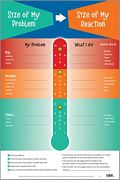
|
Size of My Problem — Poster. $15.99* *a 10% discount applies to all professional-use purchases
of Social Thinking publications.
We all experience problems; they’re a part of life. We
can’t avoid them even if we use our best social thinking. It’s a hidden rule
that when we’re around others, our reaction size (the behavior we show on the
outside) should match the size of our problem. But sometimes our feelings about
a problem are much bigger than the problem itself! The Size of My Problem poster can be used to teach students to develop their awareness of this
concept; it can also be used on the spot to help individuals figure out the
size of a problem, their reaction size, and then visually see the relationship
between them. The bottom of the poster provides some brief instructions to
encourage adults to explore with children whether or not their reaction created
a new problem.
The poster is perfect for home or classroom/clinic and
its dry-erase surface means it can be used again and again. Great teaching
companion to several of our Social Thinking® products that teach about problem and reaction size. |
Back to top
|
Social Behavior Mapping — Introducing the
Social-Emotional Chain Reaction, Revised Edition. Michelle Garcia Winner,
Editor, $38.95* *a 10% discount applies to all professional-use purchases
of Social Thinking publications.
This book is a collection of over 50 Social Behavior
Maps, covering a range of topics for home, community and the classroom. Social
Behavior Mapping is geared for use by parents and professionals to help
those with social thinking challenges understand what behaviors are expected
and unexpected in a way that makes sense to their way of thinking. The Social
Behavior Map (SBM) was developed as a cognitive behavior strategy to teach
individuals about the specific relationship between behaviors, other's perspective,
other's actions (consequences), and the student's own emotions about those
around him or her. The SBM is a visual tool that displays these abstract
concepts through a flow chart.
Social Behavior Mapping is a visual support
showing the link between a person’s behavior and the consequences they
experience. It outlines a fundamental social concept: how we act in a specific
situation affects how others feel, how we make others feel affects how they
treat us, and how we are treated affects how we feel about others and,
ultimately, about ourselves.
Many of our students are able to see expected and
unexpected behaviors in others but struggle with recognizing and understanding
how their own behaviors affect others. Social Behavior Maps help students
figure out that they have social judgments about others and that others have
judgments about them. Social Behavior Mapping makes the complicated
process of how we affect each other visual and concrete. |
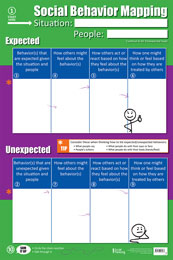
|
Social Behavior Mapping + 10 Steps (Dry Erase Template). $18.95* (ages 8 – Adult) *a 10% discount applies to all professional-use purchases
of Social Thinking publications.
Provides a visual map that helps students connect the dots between their own and others' thoughts, emotions, and behavior. The dry erase surface means the poster can be used and reused across the day and different contexts.
This poster is also sold as part of the Social Thinking - Four Posters for the Classroom & Treatment Room set |
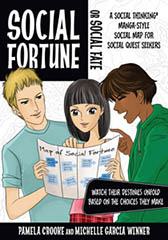
|
Social Fortune or Social Fate: a Social Thinking Graphic Novel Map for Social Quest Seekers. Michelle Garcia Winner & Pam Crooke, $35.95* *a 10% discount applies to all professional-use purchases
of Social Thinking publications.
Utilizing the graphic novel with anime illustrations concept to capture the attention of teens, we have developed this book to teach the core concepts related to Michelle Garcia Winner’s Social Behavior Mapping (SBM). The core of the book consists of 10 social scenarios, each one scenario is played out through the lens of Social Fortune or Social Fate by demonstrating visually how a situation can change quickly based on how someone reacts within it. Every scenario begins with a mini-story told through a four pictured comic strip which then leads the protagonist to a decision making point. If the decision made leads to others feeling good and ultimately the character feeling good about him or herself, this will be represented as “social fortune.” However, if the protagonist makes a decision that traps him/her and peers/adults in an uncomfortable or frustrating situation, this leads to “social fate.”
This book is unique in its layout and format. The first cover depicts the Social Fortune side of the book; but when the reader turns the book over, the back side of the cover appears up-side down. This is the Social Fate side — a playful way to point out two different points of view. |
Back to top
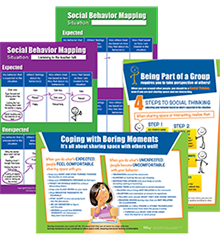
|
Social Thinking - Four Posters for the Classroom & Treatment Room. Michelle Garcia Winner, $66.95* (ages 8-10, Ages 11-13) *a 10% discount applies to all professional-use purchases
of Social Thinking publications.
The idea for the Social Thinking posters came from repeated requests by educators for explicit visual information they could use in the classroom to reinforce some of the core Social Thinking concepts. Teaching in a classroom requires that students not only attend to what they are learning but also be actively engaged in appropriate social behavior for that environment. These posters help keep that learning on track by providing a constant visual reference of key social concepts.
All four posters provide information in a lighthearted way, encouraging humor and interaction in teaching Social Thinking and related skills. They provide an avenue for teachers and students to engage in concrete, explicit discussions about defining the variables that encourage more appropriate Social Thinking in the classroom. Not just for students with social learning challenges, the teaching concepts on these posters can help ALL students become better social thinkers and classroom participants. A perfect learning tool for the classroom, a therapy room, or even in the home.
- Coping with Boring Moments: Helps students understand the expected and unexpected behaviors related to boredom
- Being Part of a Group: Lays out the four steps of perspective taking that are at the heart of our social thinking and keep us working together as a group
- Social Behavior Mapping – Dry Erase Template: Provides a visual map that helps students connect the dots between their own and others' thoughts, emotions, and behavior. The dry erase surface means the poster can be used and reused across the day and different contexts
- Social Behavior Mapping – Listening to the Teacher Talk: A sample map filled out to give students a visual tool for the expected and unexpected behaviors involved in being part of the classroom learning environment
- The posters can be purchased as a set or individually
- Dimensions: 24" x 36"
|
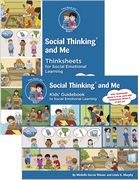
|
Social Thinking and Me: Thinksheets and Guidebook. Michelle Garcia Winner & Linda Murphy, $90.95* (2
volume set); Also available: Social Thinking and Me: Kids' Guidebook to Social Emotional Learning. Michelle Garcia Winner & Linda Murphy, $42.95* (Guidebook only) *a 10% discount applies to all professional-use purchases
of Social Thinking publications.
Whether you’re new to Social Thinking or a veteran in
using their materials, Social Thinking and Me is the perfect tool to
introduce and teach core Social Thinking Vocabulary and concepts to older
elementary school and middle school-age kids (ages 8-14). This two-book set
breaks larger and more complicated social concepts down into smaller chunks to
make it easier for adults to teach and easier for kids to learn.
- No prior knowledge of Social Thinking or teaching our methodology
is needed! Can be used by teachers in mainstream or inclusion classrooms, by
therapists in individual or small group settings, and by parents as a
teaching/learning tool to help kids with social learning.
- Social Thinking and Me uses language that is
understandable to both kids and adults, and breaks down complex topics in a way
that is clear and manageable to both new and familiar learners of Social
Thinking. Its voice is guiding, kid friendly, and sometimes humorous
|
|
Social Thinking® Social Learning Tree — Poster. $15.95* *a 10% discount applies to all professional-use purchases
of Social Thinking publications.
Teaching individuals to be better social thinkers
requires us to start our teaching at the foundation level and build up from
there. Our Social Thinking Social Learning Tree poster visually explores
the social learning process and is a reminder of how social skills start from a
root system that is built upon social thinking and social problem solving. |
Back to top
|
Social Thinking® Thinksheets for Tweens and Teens,
Revised. Michelle Garcia Winner, $52.95* (ages 11-18) *a 10% discount applies to all professional-use
purchases of Social Thinking publications.
Versatile and ready-to-use, this collection of over 160
thinksheets (worksheets that make you think!) help pre-adolescents and
adolescents learn to navigate the increasingly complex social world. Because
social rules and expectations change quickly with age, thinking and behaviors
that are appropriate in elementary school can quickly become unexpected and
problematic as students move into middle and high school. This book zeroes in
on the real and pressing social challenges faced by tweens and teens, such as
managing social anxiety, making friends, dealing with bullies, understanding
body language, filtering thoughts and blurting, fitting in, and much more.
Divided into eight core social concept sections, this
hands-on workbook is a structured, systematic approach that presents social
concepts and situations as they increase progressively in complexity. This
design supports special and mainstream educators, therapists, and parents in
individualizing instruction as they help students thoughtfully explore and
practice key social competencies before they are expected to use them in
real-life situations. Topics include:
- Learning about others’ perspectives
- Discovering the hidden rules at school
- Reacting, overreacting, and other emotional challenges
- Being bossy and jerky
- Understanding when complete honesty may not be the best policy
- Knowing the difference between friendliness, friends, and mean
people
- Working effectively with others
The thinksheets are mini-lessons that break down abstract
social concepts into small concrete chunks of information in a way that sticks
with the learner. Like all materials from Social Thinking®, the
thinksheets not only show which skills to use and when, but also “the why”
behind the social skill instruction, bolstering learning and application for
life beyond adolescence. Many educators have found that while this book was
first developed for students with social learning challenges, it benefits virtually
all students in the mainstream classroom. Thinksheets can be used as-is or
modified to better suit an individual student’s learning needs. In addition,
the thought-provoking strategies found in this book work powerfully in tandem
with the information in Social Fortune or Social Fate and Socially
Curious and Curiously Social, two more Social Thinking books written
expressly for tween and teen readers. |
|
Social Town Citizens Discover 82 New Unthinkables for Superflex® to Outsmart! Introducing Superflex’s Very Cool Five-Step Power Plan and the Unthinkables©. Stephanie Madrigal, Michelle Garcia Winner & Pamela Crooke, $55.95* (ages 7-10+) *a 10% discount applies to all professional-use purchases
of Social Thinking publications.
This latest edition in the Superflex® series is a compilation work that introduces 82 new Unthinkables and 14 new Thinkables submitted by Social Town citizens of all ages. Unthinkables and Thinkables are grouped by theme/category for easy reference by student or adult, and each entry includes the character’s power, related information about its characteristics, and strategies to defeat the Unthinkable or bolster a Thinkable's help. The focal point of the book is a brand new teaching strategy developed by Stephanie Madrigal and Michelle Garcia Winner called Superflex’s Very Cool Five-Step Power Plan. It provides students with even more tools to strengthen their social processing. |
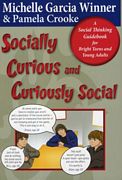
|
Socially Curious and Curiously Social: a Social Thinking Guidebook for Bright Teens and Young Adults. Michelle Garcia Winner & Pamela Crooke, $35.95* *a 10% discount applies to all professional-use purchases
of Social Thinking publications.
This book is a “get real” discussion about what really goes on inside the mind of people as we share space together. From discussing the “ins and outs” of what it means to be a “Social Thinker” to figuring out texting, dating, the many different levels of friendship and the many and varied emotions we experience as we relate to others, the authors describe the “real world” of being with other people. |
Back to top
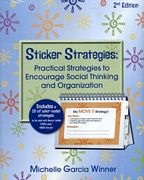
|
Sticker Strategies: Practical Strategies to Encourage Social Thinking and Organization, 2nd Edition. Michelle Garcia Winner, $34.95* *a 10% discount applies to all professional-use purchases
of Social Thinking publications.
Sticker Strategies includes over 80 fundamental social skills strategies that can be applied to a spiral-bound set of index cards for a student to use at his or her desk while at school or home. Topics include:
- Asking for Help
- Emotions & Problem Solving
- Organization, Writing and Homework
- Group Work
- Social Thinking
- Family Time — Home Strategies
The goal of the sticker strategy tool is for teachers to work with students to determine which strategies or social thinking reminders fit best for each student; a small book of key strategies can then be developed based on the student's needs that the student can transport between home and school. |
|
|
Superflex® BINGO: Teaching through the Bingo
Board. Tara Estes and the Superflex Team, $44.95* (ages 7-10+)*a 10% discount applies to all professional-use purchases
of Social Thinking publications.
Note: This is not a stand-alone teaching tool, do not
introduce this game until your students have completed You Are a Social
Detective! and the Superflex curriculum.
Unlike traditional Bingo games where players match
pictures or numbers, Superflex Bingo engages players in “thinking
through the Bingo Board.” Students listen to a situation read aloud and figure
out a Social Thinking concept or Superflex character that fits the situation,
placing a game piece on the square that matches their thinking. The game is
designed so that all players “win” by getting bingos during the session,
alleviating the behavior dysregulation that can often occur in competitive
games. Superflex Bingo is 12 games in one, providing 12 different themed card
packs to keep students engaged and learning through the year (examples include
Classroom, School Field Trip, Community, Winter Holidays, Summer Vacation,
etc.). Make it 13 games by downloading the free themed card pack for St.
Patrick’s day!
Since all players participate in each turn, Superflex
Bingo provides a framework for kids to learn a variety of social concepts
while actively thinking about the powers of Superflex characters. Kids practice
perspective taking as they imagine themselves and their own thoughts and
feelings — and those of others — in different situations. They also continually explore
Social Thinking Vocabulary concepts such as thinking with your eyes, body and
brain in the group, expected and unexpected behavior, identifying the size of
the problem, etc. As students become familiar with these social concepts and
more, they build skills that ultimately lead to social problem solving and
self-regulation. |
Back to top
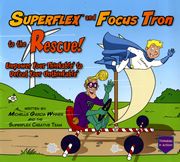
|
Superflex® and Focus Tron to the Rescue! Empower Your
Thinkable® to Defeat Your Unthinkable®. Michelle Garcia Winner, $32.95* (ages 7-10+) *a 10% discount applies to all professional-use purchases
of Social Thinking publications.
Superflex and Focus Tron to the Rescue! introduces
readers to the Thinkable Focus Tron. Wherever they are — at school, or home, in
the community — Focus Tron helps Social Town citizens remember to use their
focusing powers to stay connected to what they’re doing or what others are
talking about. In the story, Sarah periodically get visits from the Unthinkable
Brain Eater who distracts her thoughts away from her classwork, homework, and
listening to the teacher. Thanks to a lesson from the Superflex Academy and
assistance from Focus Tron and other Superflex pals, she learns strategies to
keep her thoughts on track.
This engaging book is part of our Superflex series, which
is designed to help children learn about their own and others’ thoughts and
behaviors, and practice strategies for self-regulation across a variety of
situations. As kids learn strategies to defeat the Unthinkables and unexpected
behavior, they strengthen their flexible thinking and are better able to
self-regulate in challenging times. |
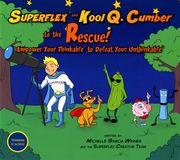
|
Superflex® and Kool Q. Cumber to the Rescue! Empower
Your Thinkable® to Defeat Your Unthinkable®. Michelle Garcia Winner, $29.95* (ages 7-10+) *a 10% discount applies to all professional-use purchases
of Social Thinking publications.
Superflex and Kool Q. Cumber to the Rescue! introduces readers to the Thinkable Kool Q. Cumber (we call him Kool, for
short!). Kool helps Social Town citizens stay calm when problems happen, and
use strategies they learn to figure out the size of a problem and the expected
reaction size. In the story, Aiden and his classmates present science projects,
but Aiden’s friend Sam becomes frustrated with problems throughout the day. As
Sam feels his brain being invaded by Glassman, he uses the strategies he
learned from Kool and the five Power Pals to calm down and have a reaction that
matches the size of the problem.
|
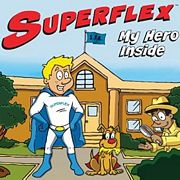
|
Superflex: My Hero Inside (Music CD). Think Social
Publishing, $21.95 (ages 7-10+) *a 10% discount applies to all professional-use purchases
of Social Thinking publications.
Sing your Unthinkables to rest with these 13 fun, catchy,
and educational songs that support children's social emotional learning as
taught through the Superflex curriculum! Each song is an upbeat combination of
music and lyrics that can help kids learn more about Social Town, the sneaky
Unthinkables, and training at the Superflex Academy to help them seek their
"Hero Inside". Music and lyrics are based on the concepts and
characters in the original Superflex curriculum created by Stephanie Madrigal
and Michelle Garcia Winner. |
Back to top
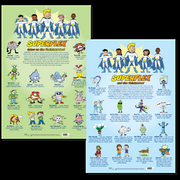
|
Superflex Posters 2 Pack. $31.50* (ages 8-10, ages 11-13) *a 10% discount applies to all professional-use purchases
of Social Thinking publications.
These Superflex posters are the perfect visual tools to guide students in using their superflexible social thinking and learning the concepts and strategies taught in Superflex: A Superhero Social Thinking Curriculum. The characters on the posters are positioned so that the Unthinkable-Thinkable pair is found in the same spot on each poster. |
|
|
Superflex® Super Sticker Collection: Unthinkables & Thinkables. Think Social Publishing, $28.95* (ages 8-10) *a 10% discount applies to all professional-use purchases of Social Thinking publications.
16 sheets! 500 stickers! Use these colourful Superflex® stickers at home, at school, or on the go!
Superflex and the Team of Thinkables are within each of us and give us powers to figure out how to adapt our behavior based on what’s going on in different situations. Use Thinkable Stickers to:
- Encourage a social learner to call on the powers of their Superflex
- Each Thinkable adds to one’s overall Superflexible thinking providing extra “power”
- Acknowledge success when a social learner uses the powers of a specific Thinkable or their own personal Superflex, in general.
The Unthinkables provide specific powers to try and defeat a person’s Superflex along with the powers of various Thinkables. Use Unthinkables stickers to:
- Build social self-awareness by encouraging a social learner to keep an eye out for a specific or team of Unthinkables that is trying to invade the child’s brain.
- Encourage social leaders to use specific strategies to minimize the powers of an Unthinkables. For example, they can put stickers on a defeat sheet to show they are working hard to defeat a specific Unthinkable or Team of Unthinkables.
These stickers are to be used in association with lessons from Superflex®… A Superhero Social Thinking Curriculum. |
Back to top
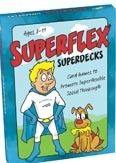
|
Superflex® Superdecks. Think Social Publishing,
$59.95* (ages 8-11) *a 10% discount applies to all professional-use purchases
of Social Thinking publications.
Kids love Superflex and are eager to explore new ways to
learn about the supportive Thinkables, the sneaky Unthinkables and discover new
strategies to defeat them, using Superflex’s very cool Five-Step Power Plan. The Superflex
Superdecks contains four standard playing card size decks, 52 cards
each, that can be used in all sorts of superflexible ways to help you teach the
who, what, when, where, and why of Superflex. Each deck comes with a game,
instructions, and answer sheet. Additional games and activities are available
in a free PDF download, along with blank templates to create your own
cards to expand and individualize each deck to your students’ needs |
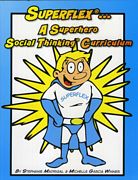
|
Superflex® … a Superhero Social Thinking Curriculum. Stephanie Madrigal & Michelle Garcia Winner, $83.95* (includes the comic Superflex takes on Rock Brain) (ages 7-10+) *a 10% discount applies to all professional-use purchases
of Social Thinking publications.
For professionals and parents to use with students in 3rd - 5th grade. Superflex®: A Superhero Social Thinking Curriculum provides educators, parents and therapists fun and motivating ways to teach students with social and communication difficulties (undiagnosed or diagnosed, such as Asperger Syndrome, ADHD, high-functioning autism or similar). The three part cognitive behavioral curriculum helps students to develop further awareness of their own thinking and social behaviors and learn strategies to help them develop better self-regulation across a range of these behaviors. The package includes the curriculum and the first Superflex comic, Superflex Takes on Rock Brain. |
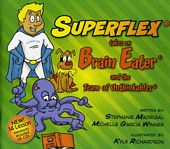
|
Superflex® Takes on Brain Eater and the Team of Unthinkables. Stephanie Madrigal & Michele Garcia Winner, $39.99* (ages 7-10+) *a 10% discount applies to all professional-use purchases
of Social Thinking publications.
Superflex Takes On Brain Eater focuses on one of the social cognitive challenges we see most often in our students — distractibility! The engaging comic book is the third in our Superflex series designed to help children learn more about their own social behavior and strategies to regulate it! |
Back to top
|
Superflex® Takes on Glassman and the Team of Unthinkables. Stephanie Madrigal & Michele Garcia Winner, $35.95* (ages 7-10+) *a 10% discount applies to all professional-use purchases
of Social Thinking publications.
Superflex Takes On Glassman shows elementary school students how they can use strategies to conquer their own “Team of Unthinkables”. In the process, students learn to calm themselves and to use strategies to assess the size of problems and other issues. As students face Glassman and other Unthinkables, they build up and learn to flex nimble, new thinking skills that help them manage and work on the thoughts and behaviors that may be causing them problems. |
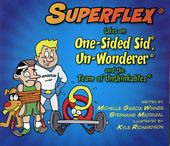
|
Superflex® Takes on One-Sided Sid, Un-Wonderer and the Team of Unthinkables. Stephanie Madrigal & Kelly Kopp, $39.99* (ages 7-10+) *a 10% discount applies to all professional-use purchases
of Social Thinking publications.
In this newest comic, children become familiar with several ways to squash the powers of two, related Unthinkable characters: One-Sided Sid, who gets people to talk only about themselves, and his sidekick sister Un-Wonderer, who likes to keep people from thinking about others. This clever duo tries to get students to do or say things that show they're only thinking about themselves and not others. |
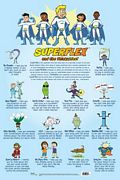
|
Superflex Thinkables Poster. Michelle Garcia
Winner, $14.50* *a 10% discount applies to all professional-use purchases
of Social Thinking publications.
Thinkables represent the expected thinking and behaviors
that kids learn through the use of the Superflex Curriculum. Several Superflex
characters, representing students’ gender and ethnic diversity, are at the top
of the poster to remind students that Superflex represents the superflexible
social thinking that’s in each of us. The poster displays each of the 14
Thinkables, their names, and each of their powers. A great visual tool for use
in the classroom, clinic, or at home – anywhere flexible thinking and
encouragement is needed! Pair it with the Superflex Unthinkables Poster to
reinforce teaching and learning.
Superflex Unthinkables Poster. Michelle Garcia
Winner, $14.50* *a 10% discount applies to all professional-use purchases
of Social Thinking publications.
The Superflex Unthinkables poster colorfully displays all
14 of the original Team of Unthinkables in a fresh new and larger format.
Several Superflex characters are at the top, to remind students that Superflex
represents the superflexible social thinking that's in each of us. The
Unthinkables range from Glassman to Rock Brain to Worry Wall and Energy Hare-y,
with the poster displaying each of their powers and how they try to sabotage
our thinking and social behaviors. Pair it with the Superflex
Thinkables Poster to reinforce teaching and learning. |
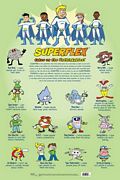
|
Back to top
|
Think Social! A Social Thinking Curriculum for School-Age Students. Michelle Garcia Winner, $133.95* *a 10% discount applies to all professional-use purchases
of Social Thinking publications.
Think Social! A Social Thinking Curriculum for School-Age Students is a social thinking curriculum to guide therapists, educators and parents who are exploring how to introduce social thinking to their students in a structured and thought out progression. Think Social is designed to assist children across the school ages who have been diagnosed with Asperger syndrome, PDD-NOS, high-functioning autism, AD/HD, hyperlexia, non-verbal learning disability (NVLD) and when there is no clear diagnosis, but social challenges are present. |
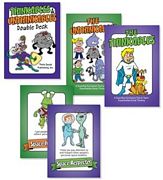
|
Thinkables & Unthinkables Double Deck. Think
Social Publishing, $29.95* (ages 8-11) *a 10% discount applies to all professional-use purchases
of Social Thinking publications.
The Thinkables & Unthinkables Double Deck is
the superflexible teaching tool you asked for to use with individuals who are
learning about or have already been introduced to Superflex, the 14
original Unthinkables, and the newer characters, the Thinkables (first
mentioned in the book, Social Town Citizens Discover 82 New
Unthinkables for Superflex to Outsmart.
- You take the lead in using the cards — they’re a blank canvas of
possibilities!
- Create games such as “Go Fish” with the cards
- Use the Thinkables cards to say “good job” when a child or
student has mostly put an Unthinkable to rest
- Use an Unthinkable card as a visual tool to remind a student to
use his/her strategies when one of those clever, sneaky characters is invading
the student’s brain
- Pick an Unthinkable or Thinkable and play “I Spy…” where students
use their Social Detective skills to look for that character showing up in
themselves or others in the group, the classroom, or the school
- The possibilities are endless, limited only by your imagination
and your own superflexible thinking!
|
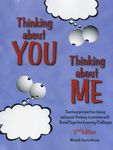
|
Thinking about YOU, Thinking about ME: Teaching Perspective Taking and Social Thinking to Persons with Social Cognitive Learning Challenges, 2nd Edition. Michelle Garcia Winner, $71.95* *a 10% discount applies to all professional-use purchases
of Social Thinking publications.
Thinking about YOU, Thinking about ME is one of Michelle Garcia Winner’s best-selling works. This newly revised edition includes 140 new pages of information, including two new chapters and an updated philosophy throughout. The assessment chapter has been re-written and expanded to include a Social Thinking Dynamic Assessment Protocol®, with more detailed assessment techniques. As well, this second edition includes:
- Winner's 3 Levels of Social Cognitive Perspective Taking
- Review of Social Cognition and Related Theories
- The 4 Steps of Communication Explained and Related Treatment Activities
- Concrete Strategies to help students become aware of the impact their words and actions have on other people's thoughts, emotions and actions
- Sample IEP Goals and Benchmarks
|
Back to top
|
Thinksheets for Teaching Social Thinking® and Related
Skills. Michelle Garcia Winner, $54.95* (formerly titled Worksheets!) *a 10% discount applies to all professional-use purchases
of Social Thinking publications.
One of Social Thinking's best-selling books, Worksheets!, now has a new name: THINKSHEETS.
Same great content, now with a new title and cover. THINKSHEETS encourages
higher functioning individuals with autism spectrum disorder, social
(pragmatic) communication disorder, ADHD, or other related social–emotional
learning challenges to process more deeply what social thinking means to them.
The curriculum works best for students mid elementary through high school. The THINKSHEETS
are coded for different aged students.
Developed from years of working with students with
social–cognitive challenges, the THINKSHEETS serve as mini-lesson plans to
introduce Social Thinking concepts. Educators can then take these concepts and
adapt them through different activities they develop. Teachers, therapists,
parents, and other caregivers can also copy and send the material to other
stakeholders in the individual’s life to reinforce the concepts the student is
learning. |
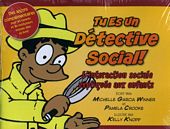
|
Tu es un détective social! L’interaction
sociale expliquéeaux enfants. Michelle Garcia
Winner & Pamela Crooke, $35.95* (ages 5-10+)*a 10% discount applies to all professional-use purchases
of Social Thinking publications. |
|
Visual Supports for 10 Key Social Thinking®
Vocabulary. Social Thinking Publishing Co., $34.95* (ages PreK to Teens) *a 10% discount applies to all professional-use purchases
of Social Thinking publications.
These visual supports encourage the active use of 10
Social Thinking Vocabulary concepts that lay the foundation for social
learning, which are fundamental to the social experience and are relevant
across languages, cultures, and ages. As each of these 10 concepts are
introduced and utilized on an ongoing basis, these related colorful visual
supports can be displayed in the classroom, clinic, or home to remind viewers
to observe and use these concepts in all locations. The 11x14” images are
beautifully rendered, and their powerful primary function is to encourage the
use of the concepts to build social awareness, self-awareness, perspective
taking, flexible thinking — and ultimately — stronger social competencies.
The visual supports are intended for use as the concepts
are introduced and used on an ongoing basis to remind adults and students to
keep these concepts alive across all settings. These concepts get to the root
of social-emotional learning for every individual, typically developing or with
social learning challenges. The 10 Social Thinking Vocabulary concepts are:
Thoughts and Feelings;
Thinking with Your Eyes; The Group Plan; Body in the Group; Whole Body
Listening; Hidden Rules & Expected—Unexpected Behaviors; Smart Guess;
Flexible and Stuck Thinking; Size of the Problem; and Sharing an Imagination
The product offers no teaching instruction — to learn how
to teach each of the concepts and the sequence we suggest other Social
Thinking® titles such as Thinking About You, Thinking About Me and Think
Social — both by Michelle Garcia Winner. |
Back to top
|
We Can Make It Better: a Strategy to Motivate and Engage Young Learners in Social Problem-Solving Through Flexible Stories. Elizabeth Delsandro, $37.95* *a 10% discount applies to all professional-use purchases
of Social Thinking publications.
We Can Make It Better! is a resource for safe and motivating social problem-solving practice. With the right tools, practice and understanding, students can learn how to make good choices — in their thoughts, actions and words — that result in improved social interactions. |
|
|
We Thinkers! Volume 1 Social Explorers Deluxe
Package. Ryan Hendrix, Kari Zweber Palmer, Nancy Tarshis, Michelle
Garcia Winner, $164.95* (ages 4-8)*a 10% discount applies to all professional-use purchases
of Social Thinking publications.
We Thinkers! Volume 1 Social Explorers is an
engaging Social Thinking educational series that combines a social learning
framework with music and dramatic play activities that will appeal to early
learners. Play is the learning environment of young children, and this
curriculum capitalizes on this idea! The We Thinkers! Volume 1 Social
Explorers Deluxe Set includes the five storybook set, curriculum
book, and a free tote bag.
Changes to the DELUXE PACKAGE of We Thinkers! Volume 1:
- Removed Music CD (as of July 2019 packages): The music activities
are still included in the Curriculum, but with technology shifting to digital,
the music album can now be purchased separately on digital music platforms.
- USB Removed (as of August 2019 packages): All materials that were
on the USB are now included in the book.
- Teaching Moments Added to Curriculum Book: This content was
already embedded into each of the five units in the Curriculum book. The
Teaching Moments were extracted as a quick reference material for facilitators
while reading the storybooks. Previously only on the USB drive, now included in
the book’s Appendix.
|
|
|
We Thinkers! Volume 1 Social Explorers 5-Storybook Set. Ryan Hendrix, Kari Zweber Palmer, Nancy Tarshis, Michelle Garcia Winner, $81.95* (ages 4-8) *a 10% discount applies to all professional-use purchases of Social Thinking publications. |
Back to top
|
|
We Thinkers! Volume 2 Social Problem Solvers: a Social
Thinking® Curriculum for the Preschool and Early Elementary Years. Ryan
Hendrix, Kari Zweber Palmer, Nancy Tarshis, Michelle Garcia Winner, $249.95*
(ages 4-8) *a 10% discount applies to all
professional-use purchases of Social Thinking publications.
We Thinkers! Volume 2 Social Problem Solvers provides the structure, curriculum, storybooks, and support materials to teach
executive functioning and social problem solving while building on the core
social concepts and Social Thinking Vocabulary introduced in We Thinkers!
Volume 1 Social Explorers. The five Social Thinking concepts featured in
Volume 2 — figuring out hidden rules and expected and unexpected behavior, making
a smart guess, having flexible versus stuck thinking, matching the size of a
reaction to the size of a problem, and sharing imagination — continue the
trajectory toward social learning achievements to last a lifetime.
In Volume 2 students decipher the social cues to share
space, flexibly interact, and regulate emotions during the ever-changing world
of play or when sitting quietly in a classroom. Social executive functioning is
difficult for early learners — especially those with social emotional learning
challenges. It involves surveying a social situation, understanding group
behavior, considering others’ perspectives, motives and ideas, thinking
flexibility, negotiating roles or turns, and self-regulating to keep emotions
and behaviors under control when problems arise. Volume 2 decodes these
concepts into small, teachable segments that kids can understand, and presents
them in an organized platform from which adults can reliably teach in a
step-by-step manner. This is an excellent curriculum for all students ages 4-7
in a mainstream setting as well as for students with social learning challenges.
- We Thinkers! curriculum
- Five paperback, full-color storybooks
- We Thinkers! GPS Book (Group Collaboration, Play and Problem
Solving)
- Tote bag
|
|
|
We Thinkers! Volume 2 Social Problem Solvers 5-Storybook Set. Ryan Hendrix, Kari Zweber Palmer, Nancy Tarshis, Michelle Garcia Winner, $79.95* (ages 4-8) *a 10% discount applies to all professional-use purchases of Social Thinking publications. |
Back to top
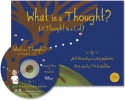
|
What is a Thought? A Thought is a Lot! Amy Kahofer & Jack Pranksy, $29.95* (ages 5-9) *a 10% discount applies to all professional-use purchases
of Social Thinking publications.
This poetic and engaging book introduces children to the amazing, creative power within us all: thought. It is not a book about changing thoughts or changing behaviors, but rather a story to help children (and adults!) see how their own thinking creates their lives, moment to moment, day to day.
Wonderfully illustrated, this children's book not only introduces young readers to the concept of thought but also the amazing power of their own thoughts. Authors Amy Kahofer and noted prevention specialist Jack Pransky tell a simple yet profound message: that our thinking creates our feelings and behavior, and when our minds are calm we have access to natural wisdom and healthy feelings.
Lesson plans and activities on the enclosed CD-ROM transform a story into a teaching tool that can be used with regular and special education students alike to explore social thinking concepts such as perspective taking, abstract language, empathy and human relatedness. |
|
Whole Body Listening Larry at Home, 2nd Edition. Kristen Wilson & Elizabeth Sautter, $28.95* (ages 4-10) *a 10% discount applies to all professional-use purchases
of Social Thinking publications.
Whole Body Listening Larry at School, 2nd Edition. Kristen Wilson & Elizabeth Sautter, $32.50* (ages 4-10) *a 10% discount applies to all professional-use purchases
of Social Thinking publications.
These colorfully illustrated storybooks provide fun ways to teach children an abstract but essential idea — that their eyes, hands, brains — their whole bodies! — communicate and affect the people around them. Being a good listener means much more than just hearing what is said with the ears. It is important to break down ALL of the components of listening for your child. Parents, teachers and therapists can use these books to teach this challenging concept at home, at school, in the car, with friends, with grandparents — and a number of other very recognizable situations. |
|
|
|
Whole Body Listening Poster. Kristen Wilson & Elizabeth Sautter, $14.50* (ages 4 – 10) *a 10% discount applies to all professional-use purchases
of Social Thinking publications.
The Whole Body Listening Larry Poster provides a fun way to reinforce lessons of the Whole Body Listening Larry storybooks! It provides a visual for the concepts of "listening" with your eyes, your brain, your heart, etc. to keep your entire body properly engaged and aware of the people around you. The books, along with the poster, help to teach self-regulation to children who may be a bit wiggly! |
Back to top
|
Why Teach Social Thinking?
Questioning Our Assumptions about What It Means to Learn Social Skills. Michelle Garcia Winner, $36.50* *a 10% discount applies to all professional-use purchases
of Social Thinking publications.
Today's children (both neurotypical and
those with social learning challenges) are entering school with declining
abilities to learn in a group, attend to a lesson, be considerate toward
others, or self-regulate their own behavior. Teachers are increasingly finding
themselves ill-equipped with the know-how, tools, and strategies to teach
students about social awareness, emotional intelligence, and self-regulation of
behavior.
If you've ever wanted, or needed, to
make a case for social instruction to be added to a student's treatment plan,
social goals written into a student's IEP, or social thinking lessons infused
into a classroom or campus curriculum plan, WHY TEACH SOCIAL THINKING drives
home the importance of social learning to a student's academic success and
later success in life. Through exploring 12 core questions, Winner attempts to
raise awareness of the many complex and interrelated issues that are at the
heart of teaching social skills. While we wait for public policy to catch up
with the ever-present and growing needs of our students, this book will open
doors to a new understanding for parents, teachers, service providers, and
administrators about effective ways to teach social thinking and related social
skills. |
|
You Are a Social Detective: Bridging the Gap Between
Social Struggles & Social Success! USB Flash Drive. Social Skill
Builder & Social Thinking Publishing, $124.95* (ages 5-10+) *a 10% discount applies to all professional-use purchases
of Social Thinking publications.
Developed in collaboration with Michelle Garcia Winner
and Pamela Crooke, and based on their book You Are a Social Detective,
this interactive USB Flash Drive teaches school-aged children to become better
social thinkers. By putting on their detective hats and deciphering expected
and unexpected social behavior, learning to make smart social guesses, and
investigating social clues, children can learn to see how others people’s
emotions and responses are connected to their own behavior. This exciting and
fun learning tool motivates students to learn while having fun! Includes:
- 6 interactive levels
- Over 200 videos targeting a range of abilities
- A fun and motivating reinforcement game
- Automatic scoring to track student responses
- Printout of Social Maps
|
|
You Are a Social Detective, 2nd Edition: Explaining
Social Thinking to Kids. Michelle Garcia Winner & Pamela Crooke,
Illustrated by Jeff Ebbeler, $37.50* (ages 5-10+) *a 10% discount applies to
all professional-use purchases of Social Thinking publications.
The social world is a big, complicated place where we are
all social detectives as we observe, gather, and make sense of the clues in
different social contexts (settings, situations, and the people in them) to
figure out the hidden rules for expected behaviors, as well as to understand
how we each feel and think about others in a situation. This 2nd edition
teaches social learners the power of observation, reading context, and
interpreting clues to then choose how to respond in ways that meet their social
goals. |
Back to top
|
The ZONES of Regulation®: a Curriculum Designed to
Foster Self-Regulation and Emotional Control.Leah Kuypers, $79.95*
(Includes USB) (ages 8-Young Adult) *a 10% discount applies to all professional-use purchases
of Social Thinking publications.
The Zones Of Regulation is a curriculum geared
toward helping students gain skills in consciously regulating their actions,
which in turn leads to increased control and problem solving abilities. Using a
cognitive behavior approach, the curriculum's learning activities are designed
to help students recognize when they are in different states called
"zones," with each of four zones represented by a different color.
Students learn how to use strategies or tools to stay in a zone or move from
one to another. Students explore calming techniques, cognitive strategies, and
sensory supports so they will have a toolbox of methods to use to move between
zones. To deepen students' understanding of how to self-regulate, the lessons
set out to teach students these skills: how to read others' facial expressions
and recognize a broader range of emotions, perspective about how others see and
react to their behavior, insight into events that trigger their less regulated
states, and when and how to use tools and problem solving skills.
The curriculum’s learning activities are presented in 18
lessons. To reinforce the concepts being taught, each lesson includes probing
questions to discuss and instructions for one or more learning activities. Many
lessons offer extension activities and ways to adapt the activity for
individual student needs. The curriculum also includes worksheets, other
handouts, and visuals to display and share. These can be photocopied from this
book or printed from the accompanying USB drive. |
|
|
Zones of Regulation Poster. Leah Kuyper, $16.50* (ages 8-Young Adult) *a 10% discount applies to all professional-use purchases
of Social Thinking publications.
This poster reinforces the teachings of The Zones of Regulation book/curriculum. Using a cognitive behavior approach, the curriculum’s learning activities are designed to help students recognize when they are in different states called “zones,” with each of the four color-coded and "road sign" oriented for clear recognition and reinforcement. Along the way, students learn how to use strategies or tools to stay in a zone or move from one to another. Students explore calming techniques, cognitive strategies, and sensory supports so they will have a toolbox of methods to use to move between zones.
- Only use dry erase pens on the poster
- Dimensions: 24" width x 18" length
|
Back to top
|
|
Zones of Regulation Three Poster Set (dry erase). Leah Kuyper, $48.95* (ages 8-Young Adult) *a 10% discount applies to all professional-use purchases
of Social Thinking publications.
Love The Zones of Regulation® self-regulation curriculum? Or maybe you're just getting started using Zones? Either way you'll love having all three of the Zones posters for your classroom, clinic, or home/homeschool. Each is a visual teaching tool in and of itself and gives you the opportunity to take advantage of all those in-the-moment teaching situations that are part of everyday life. And, all three posters are dry erase, which means you can use them again and again!
- The original Zones of Regulation poster
- The Zones STOP, OPT and GO poster
- The new Zones Triggers poster
- Dimensions 18" x 24"
- Use only dry erase markers on these posters
|
|
The Zones of Regulation Tools to Try Cards for Kids: Regulation
Strategies to Focus, Calm, Think, Move, Breathe, and Connect. Leah Kuypers
& Elizabeth Sautter, $29.50 (ages 5-10+) *a 10% discount applies to all
professional-use purchases of Social Thinking publications.
Learning to self-regulate our Zones is hard, serious work
that takes time and lots of practice. Tools to Try Cards for Kids includes
4”x 6” tool cards and is an easy, user-friendly way to introduce over 50
self-regulation strategies to kids ages 5–10 and empower them to make choices
toward figuring out what works best for them. For best teaching practice, the
strategy card deck should be used in tandem with lessons introducing tools for
use with Zones from Chapter 4 in the curriculum book, The Zones of
Regulation, as well as paired with other related products, such as Navigating
The Zones.
Housed in a sturdy two-piece cardboard box, the card deck
includes 4”x 6” strategy cards (51) and information and instruction cards (7)
for the interventionist, and weighs just 0.626. lbs. The two-sided strategy
cards are divided into five color-coded categories to show how the tools work
in different ways to help social emotional learners self-regulate feelings and
emotions:
- FEEL IT These tools use our senses to support self-regulation and
modulation.
- MOVE IT These tools integrate physical activity to impact
self-regulation and reduce anxiety.
- THINK IT These tools provide thought-based strategies to help us
self-regulate. DO IT Task and goal-oriented tools involve taking action.
- DO IT Task and goal-oriented tools involve taking action.
- CONNECT Co-regulation tools encourage empathy, thinking of
others, and accessing relationships for support.
Each strategy card displays an illustration of the self-regulation
tool performed by inclusive characters on one side and a how-to-do-it
description on the reverse. Each card includes a metacognitive self-reflection
where kids consider how they feel after using the tool, how it can be used to
help them regulate their Zones, and decide whether it’s the right tool for
them. |
Back to top


|